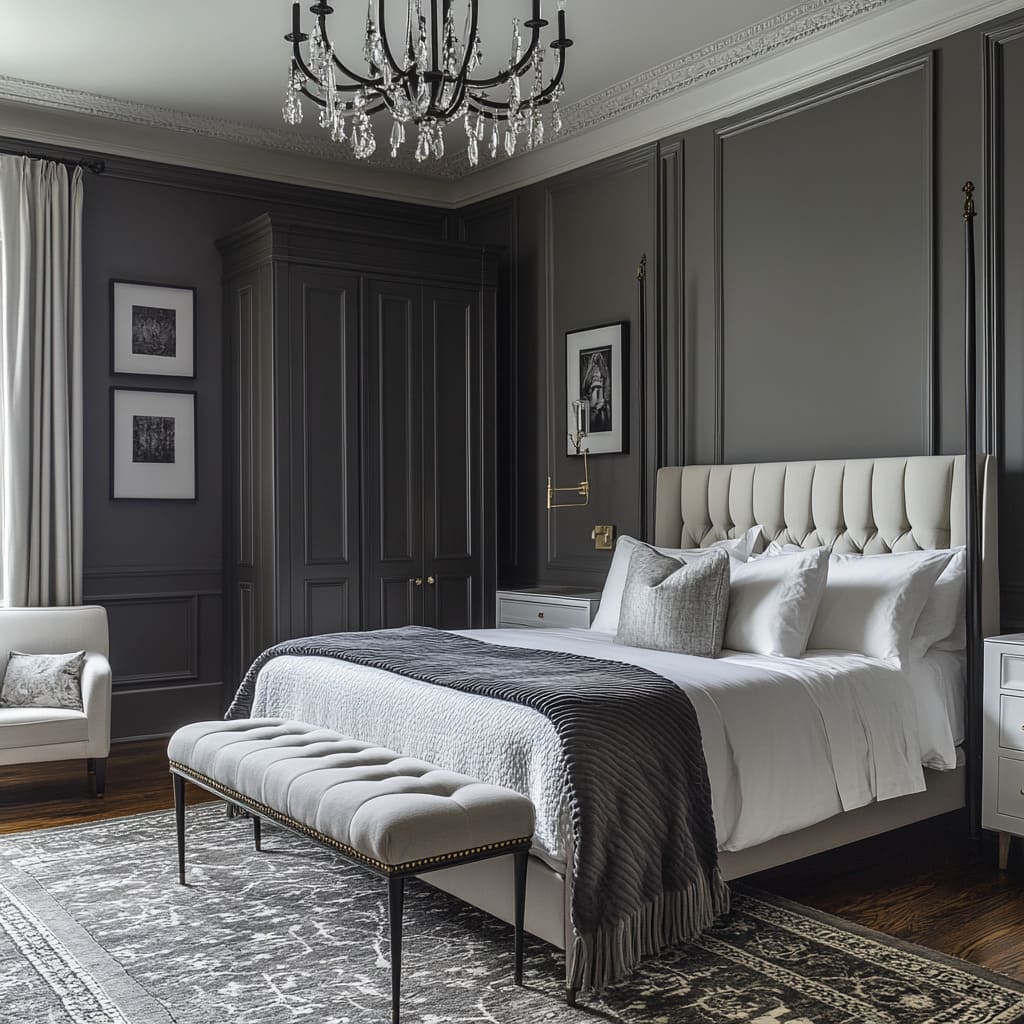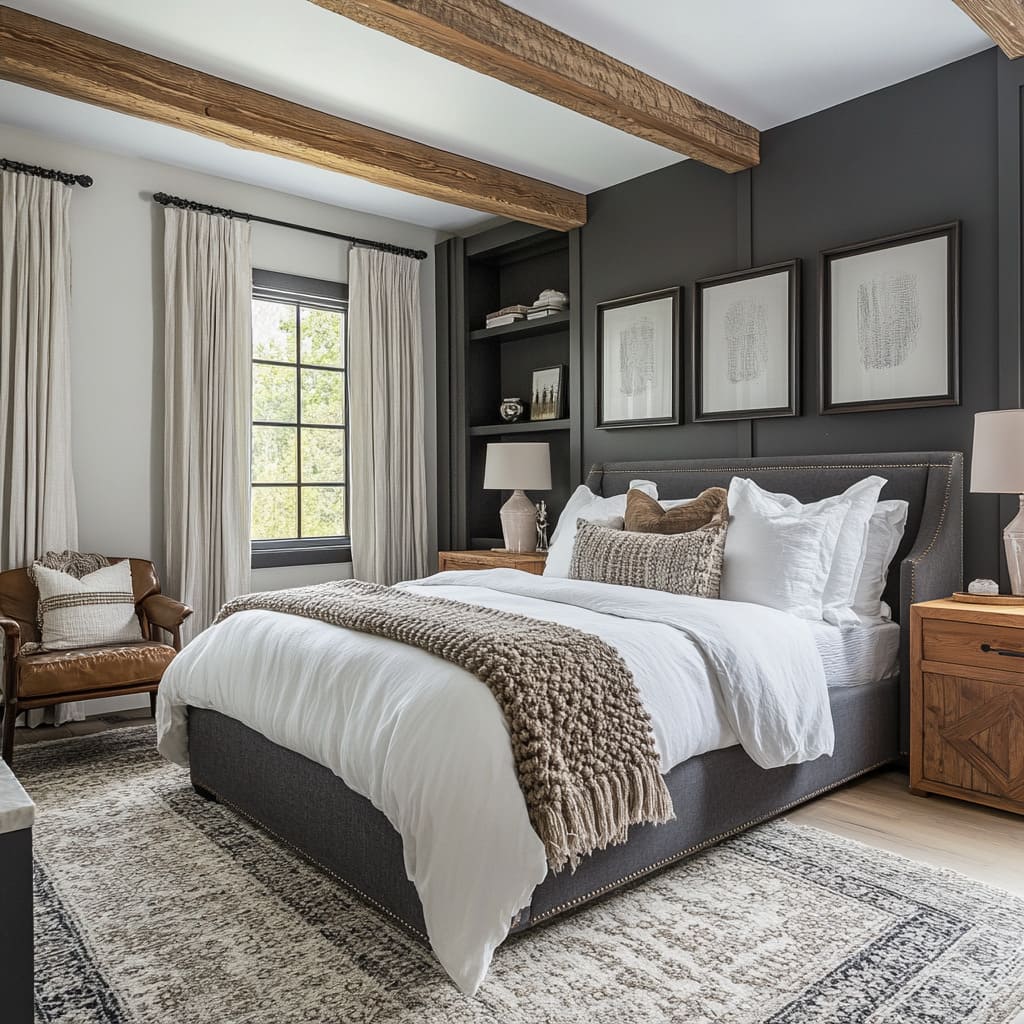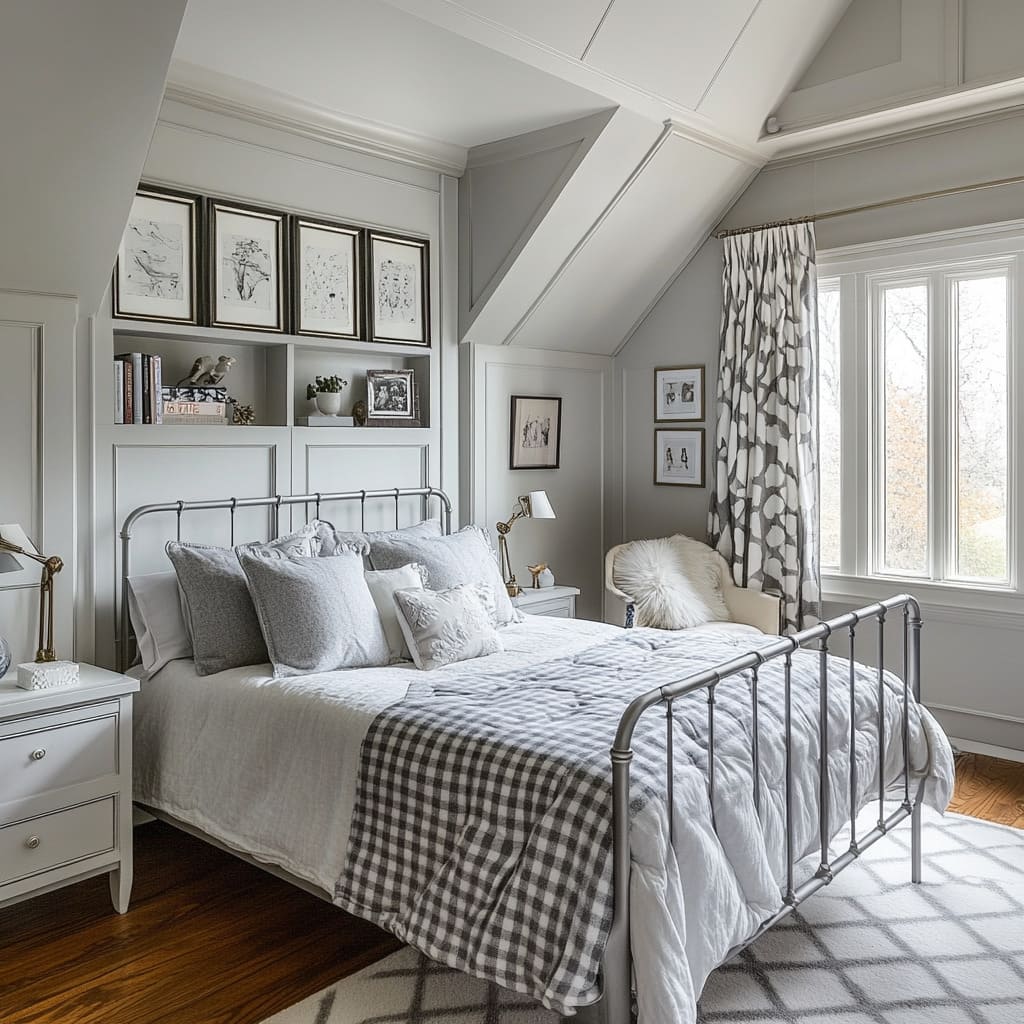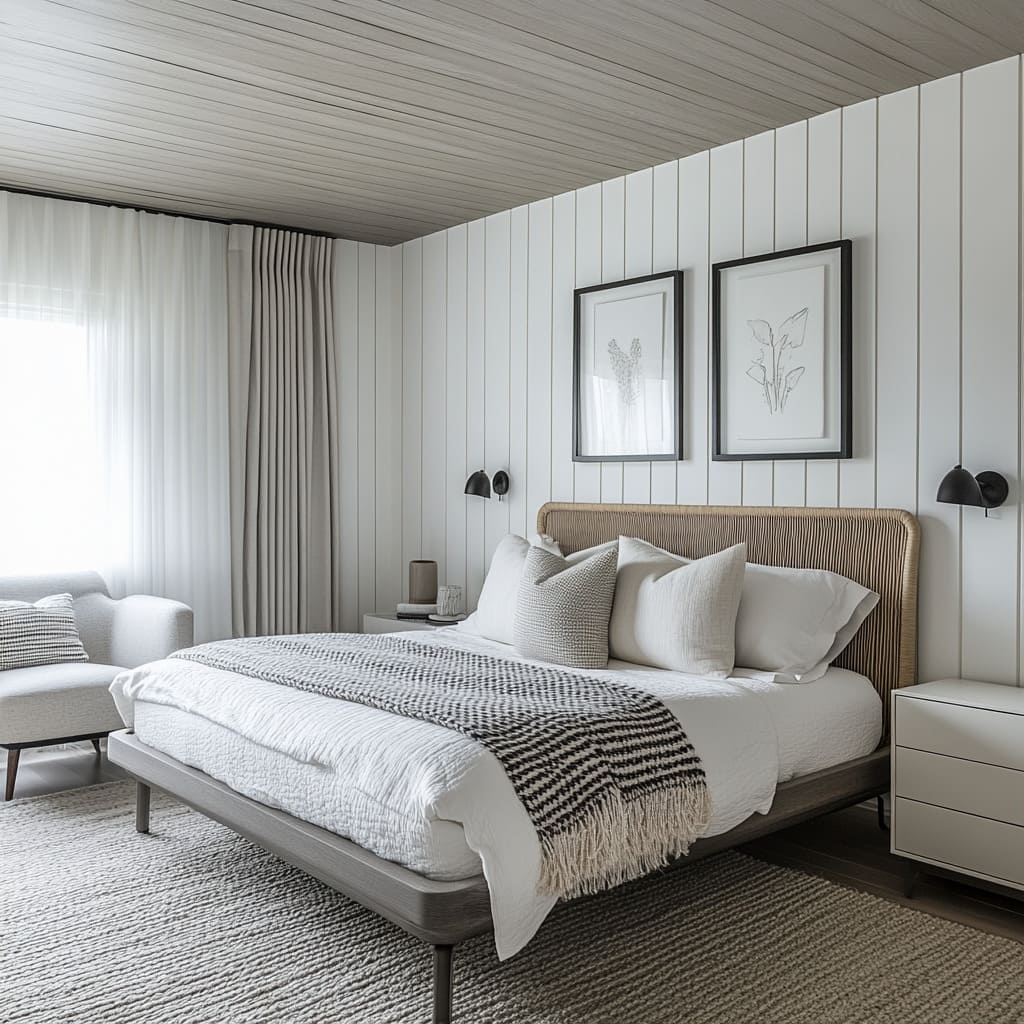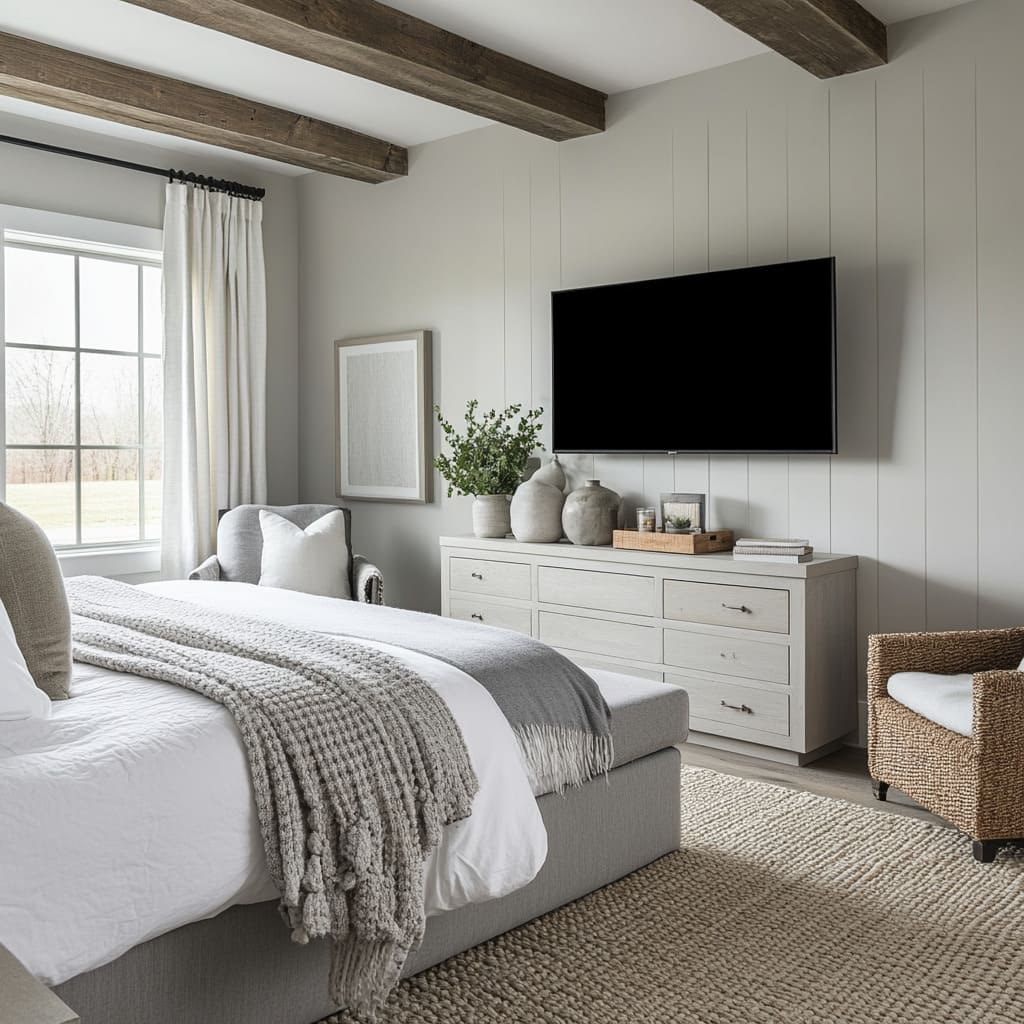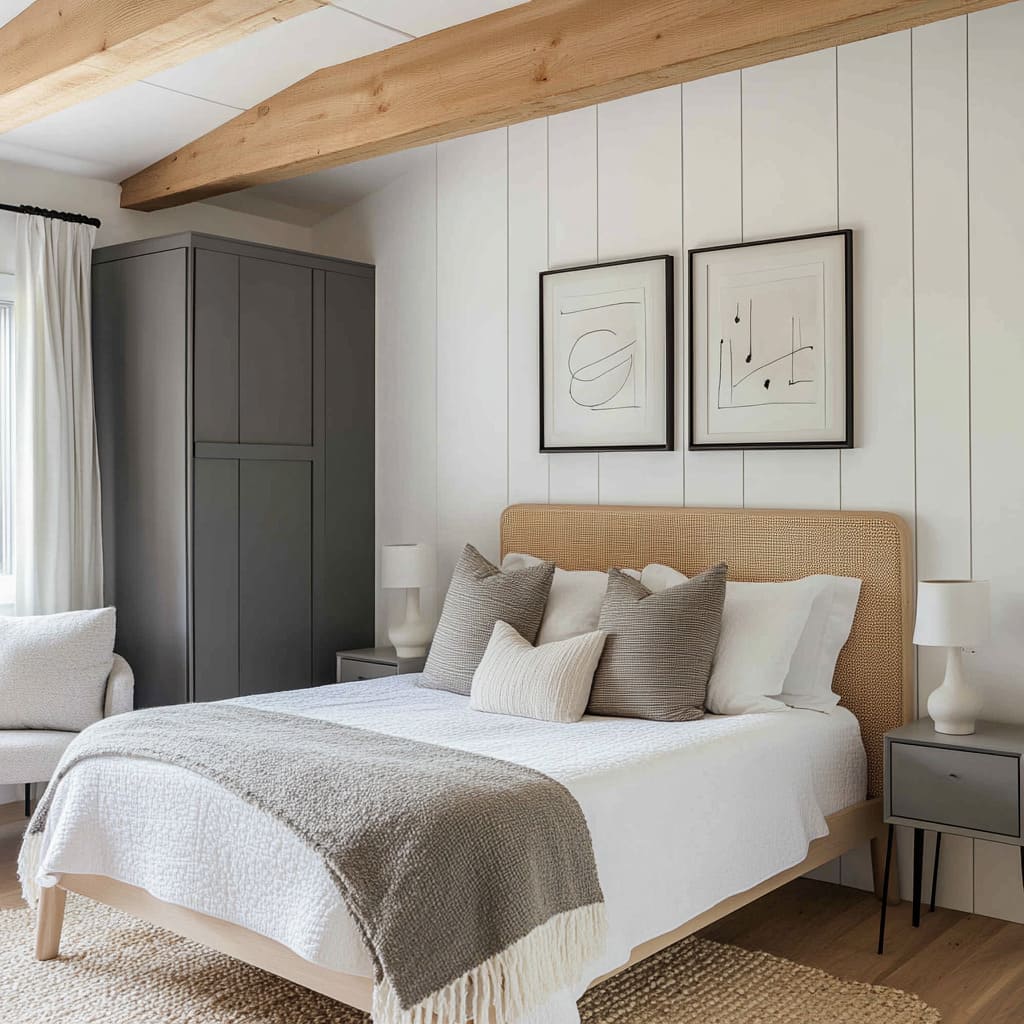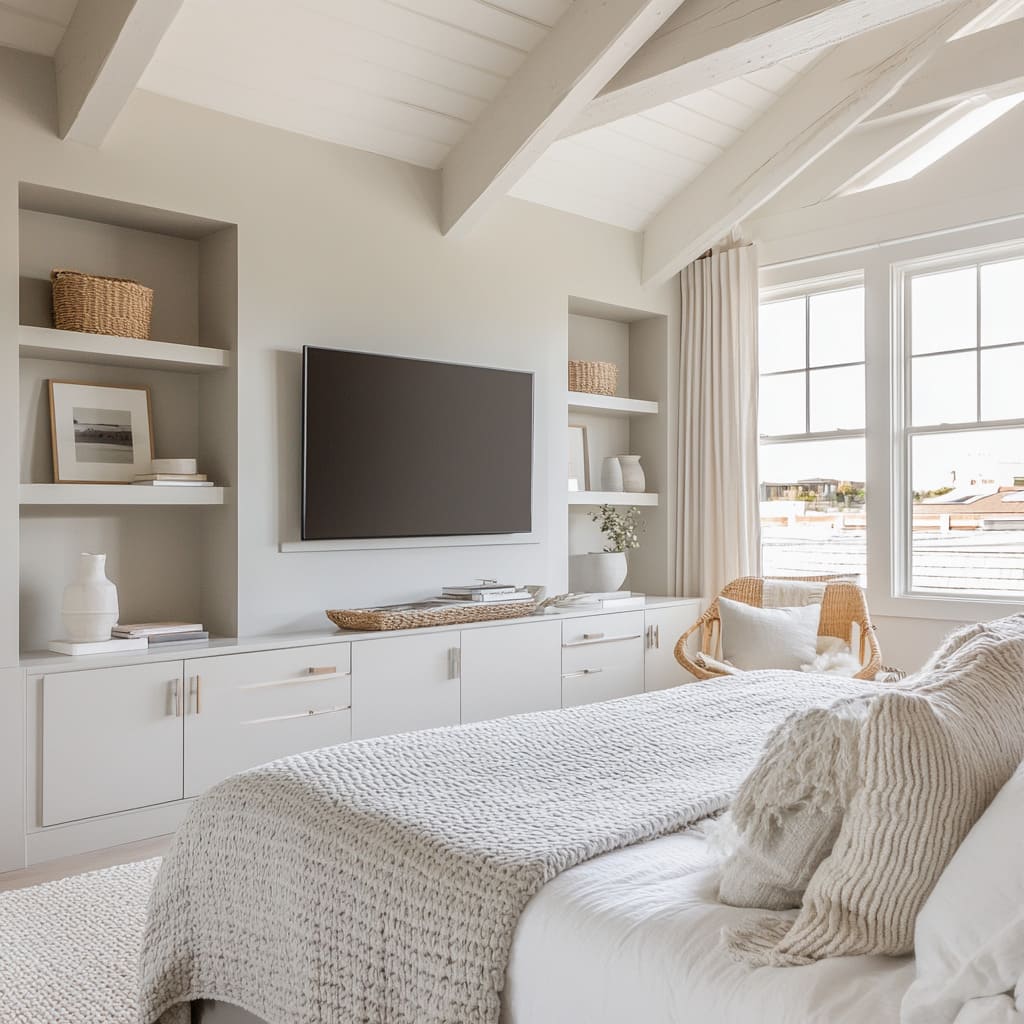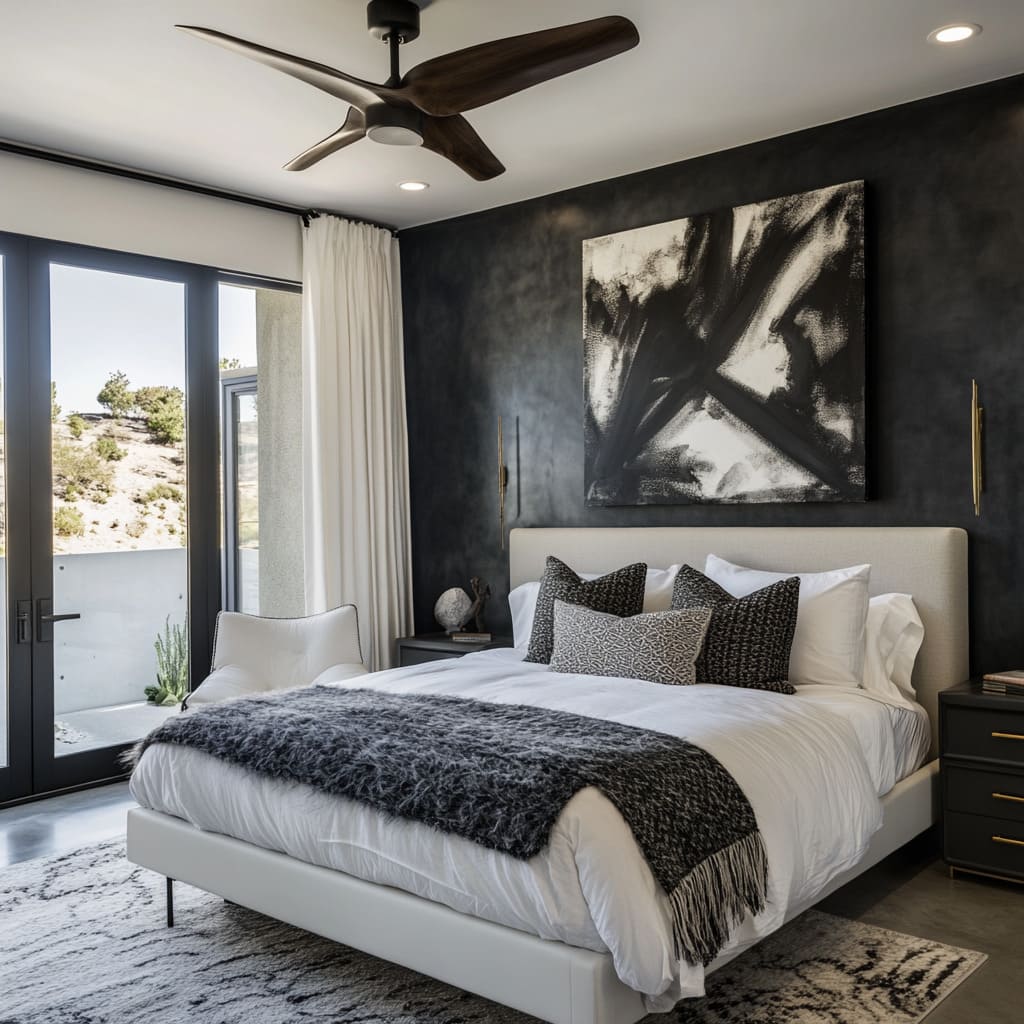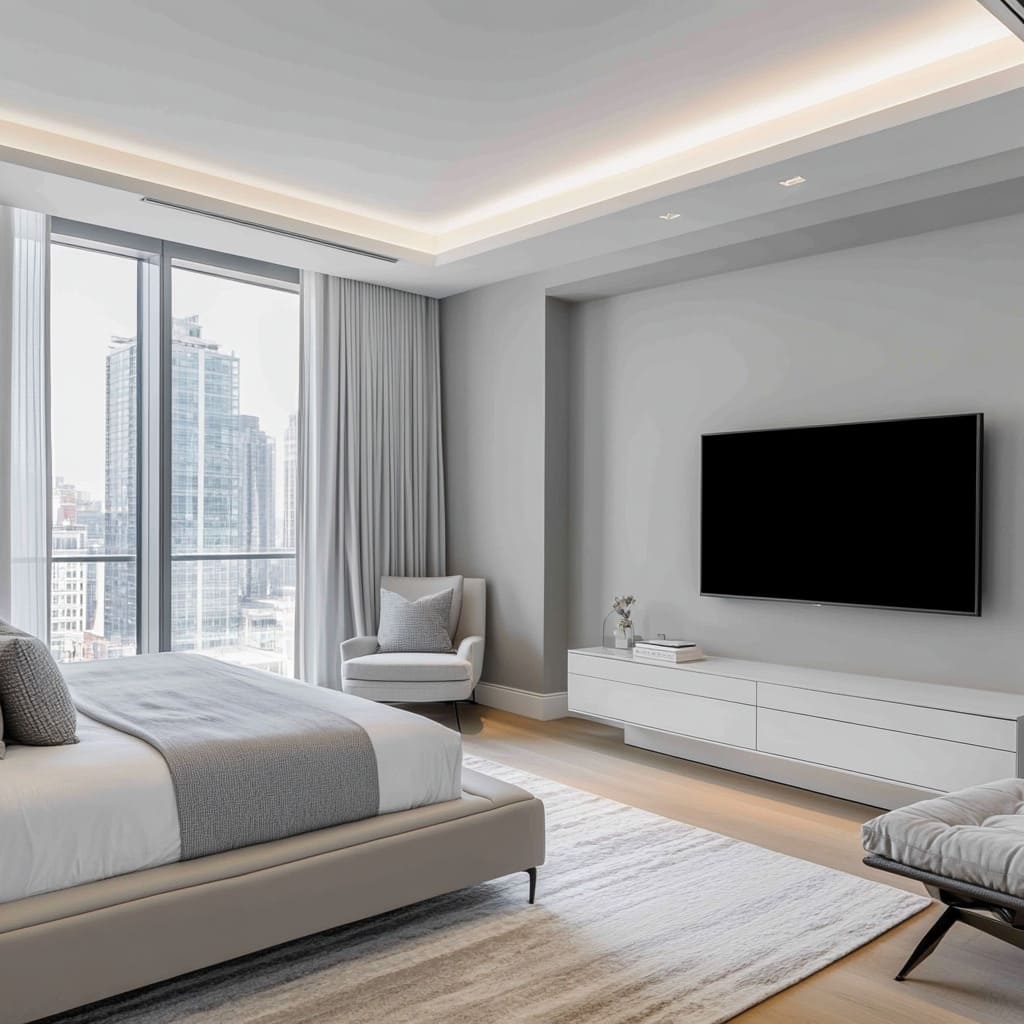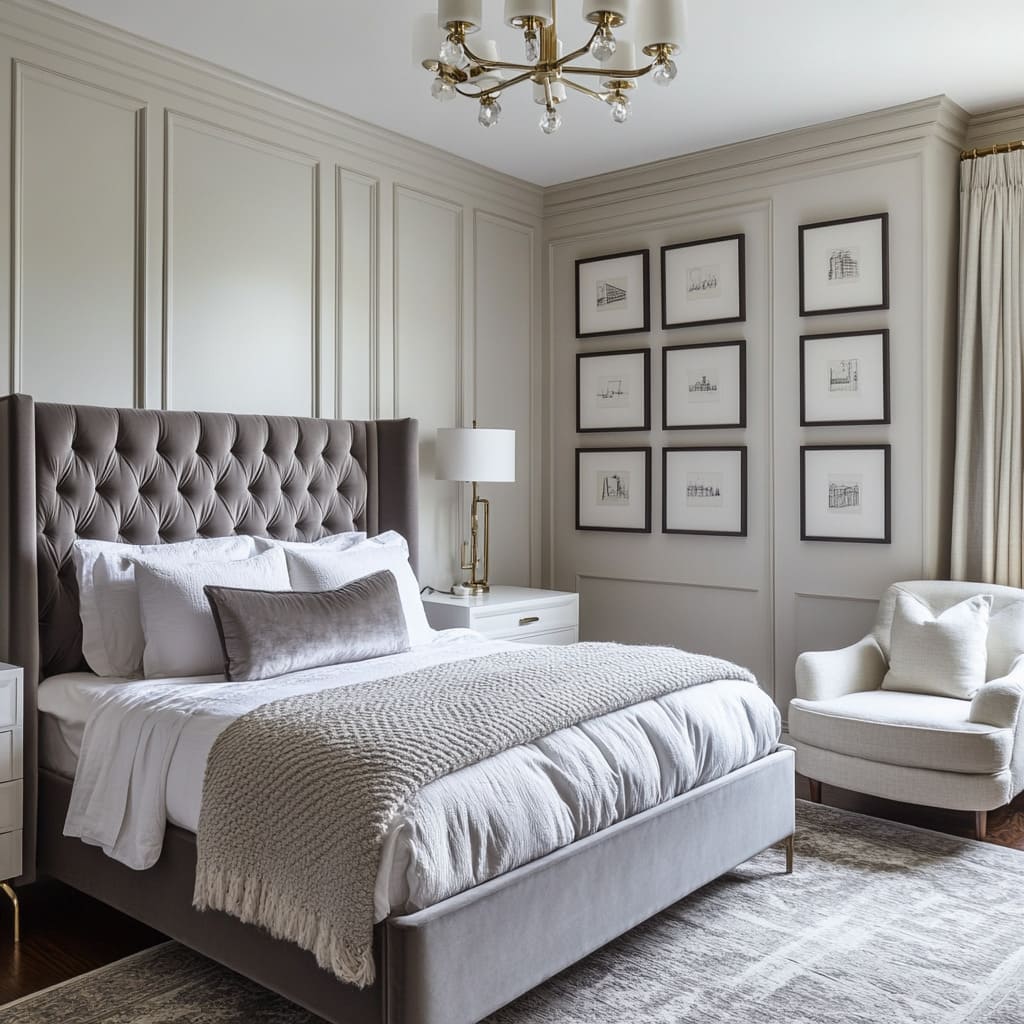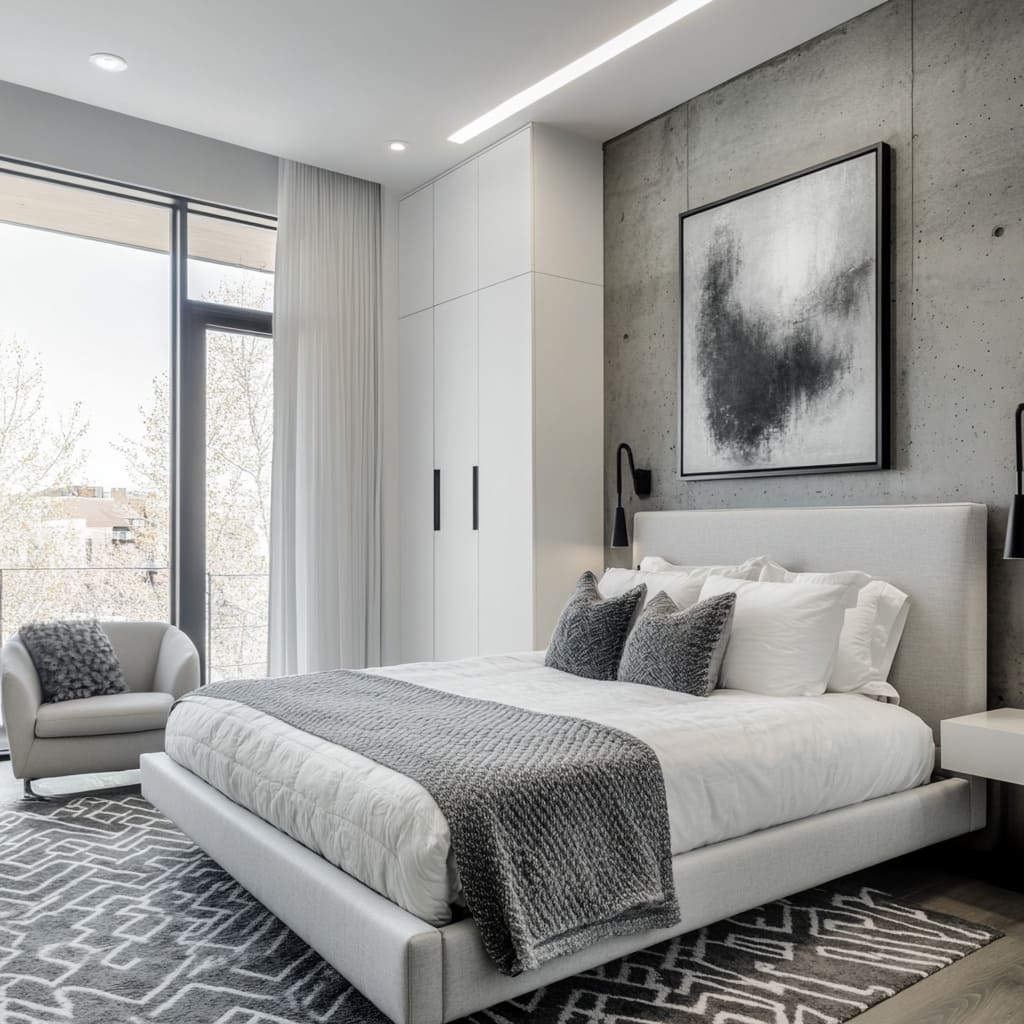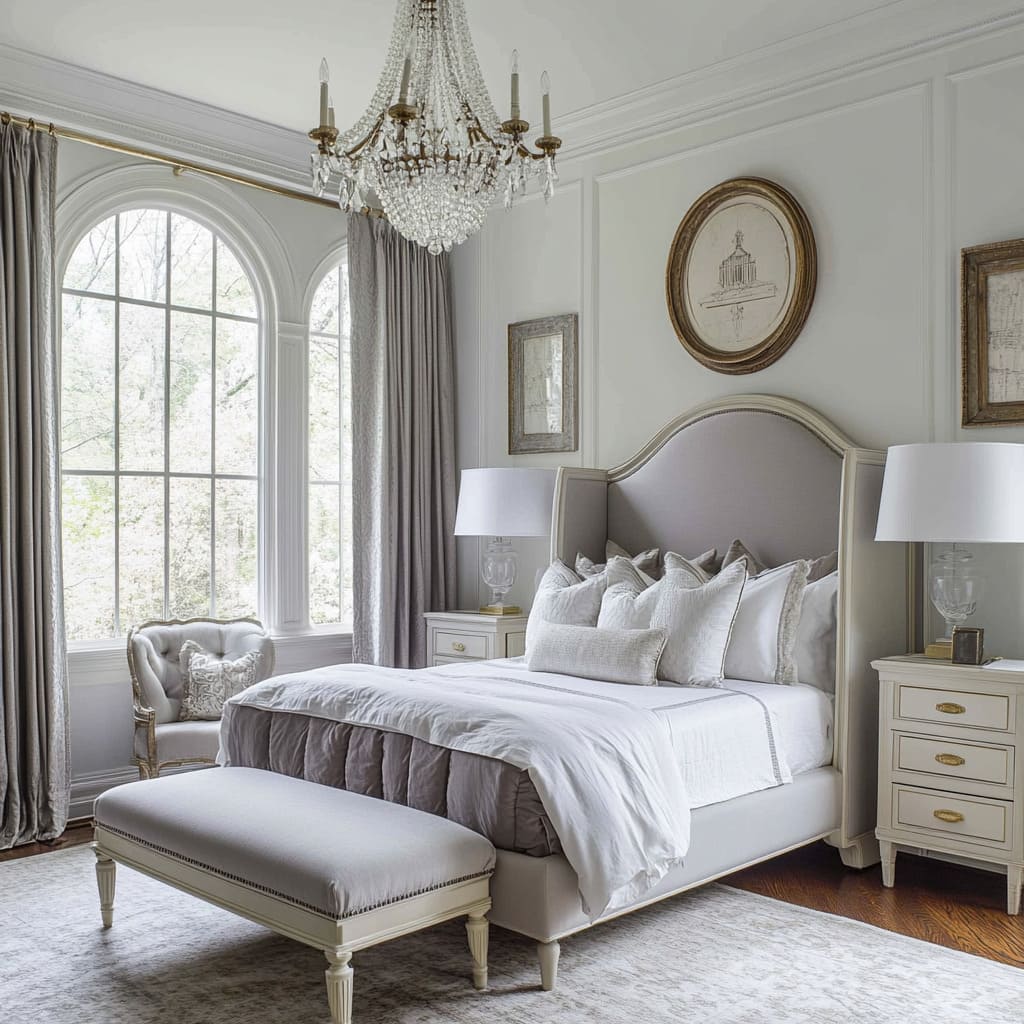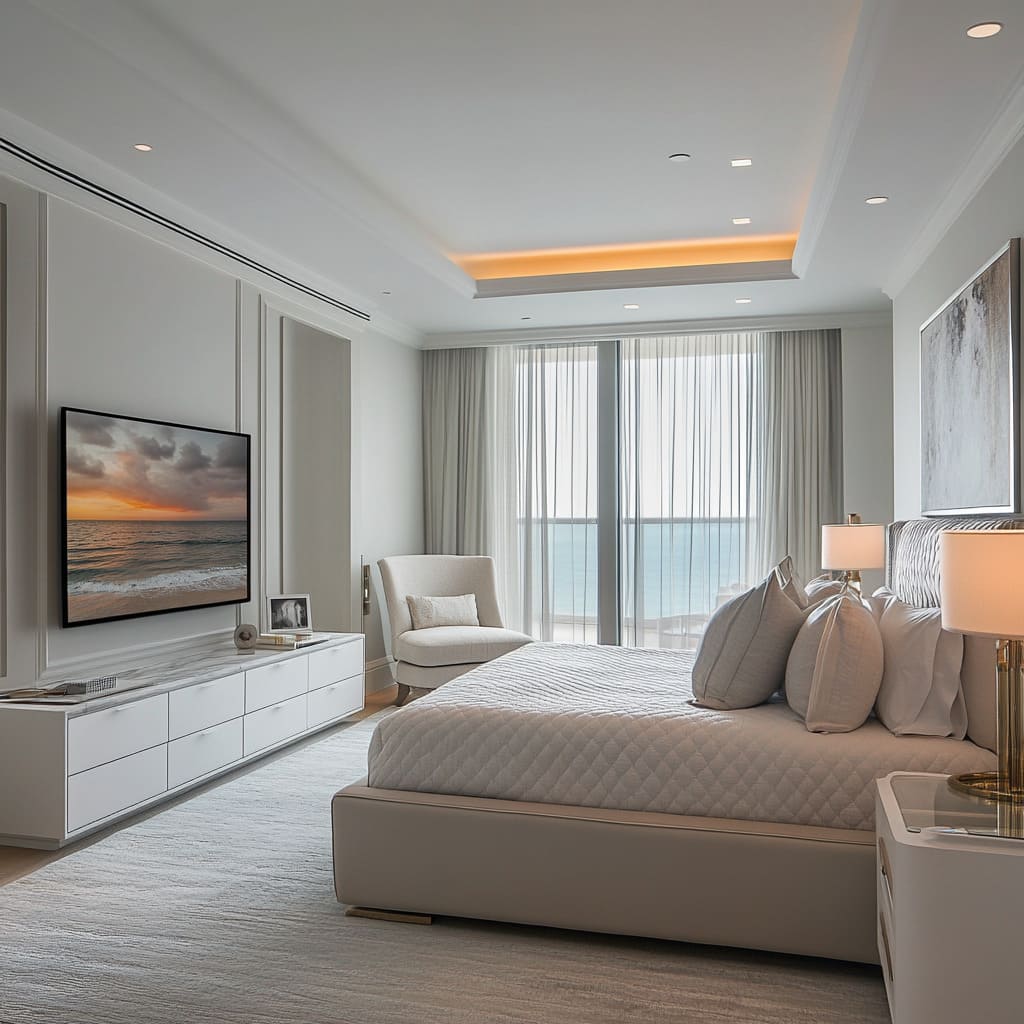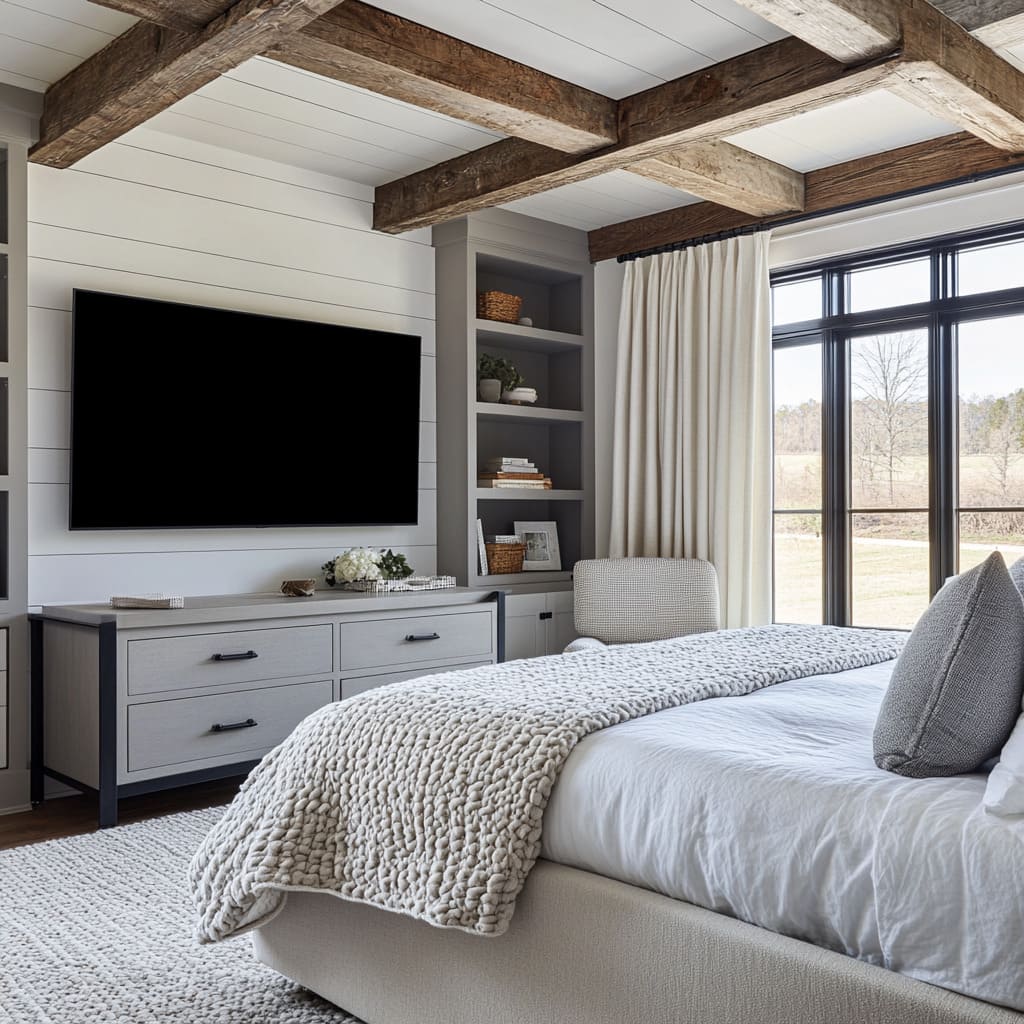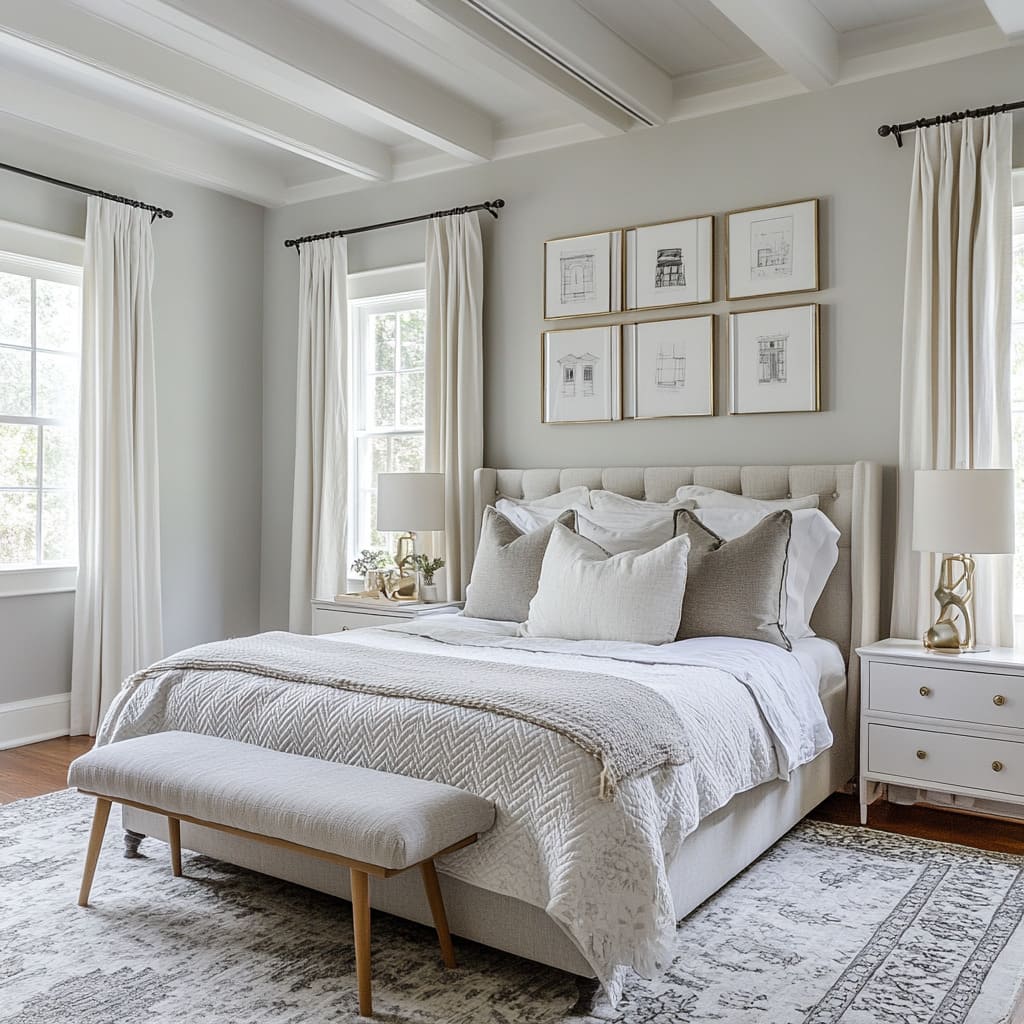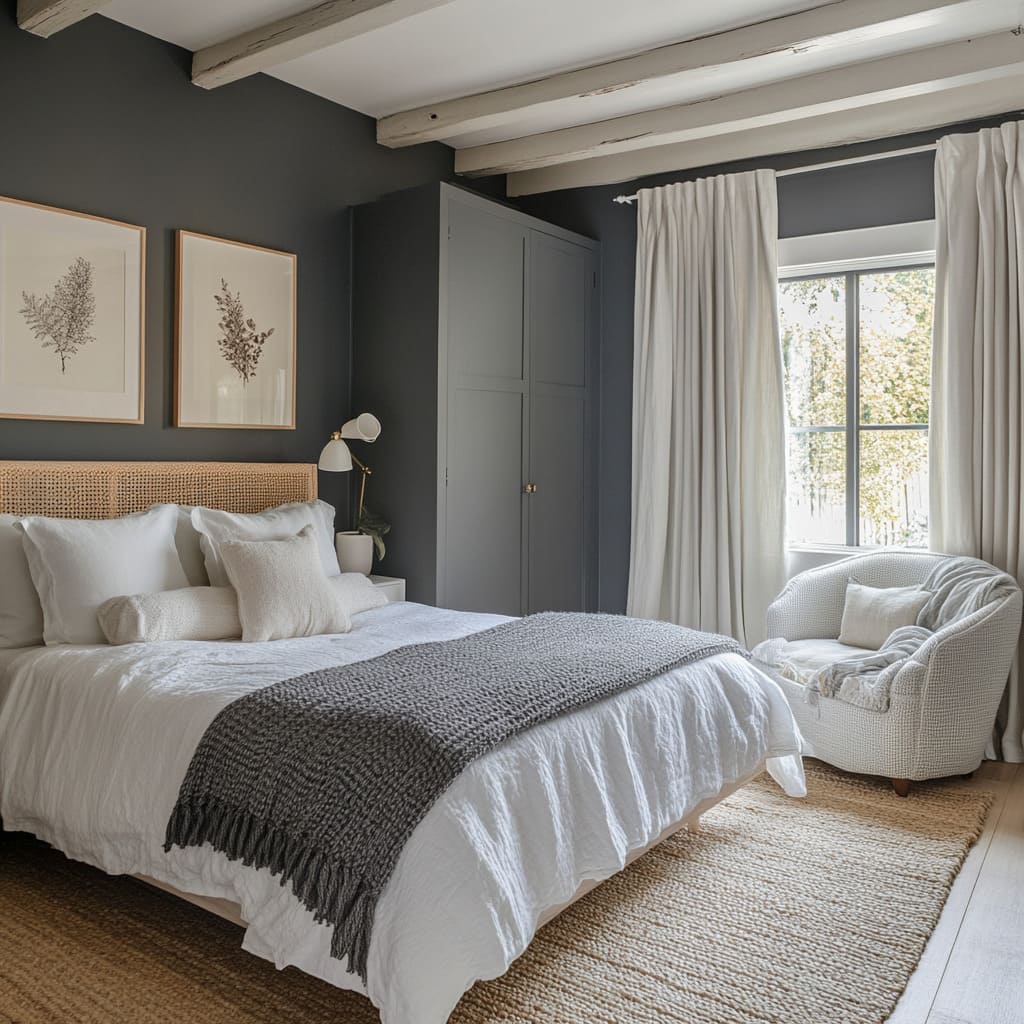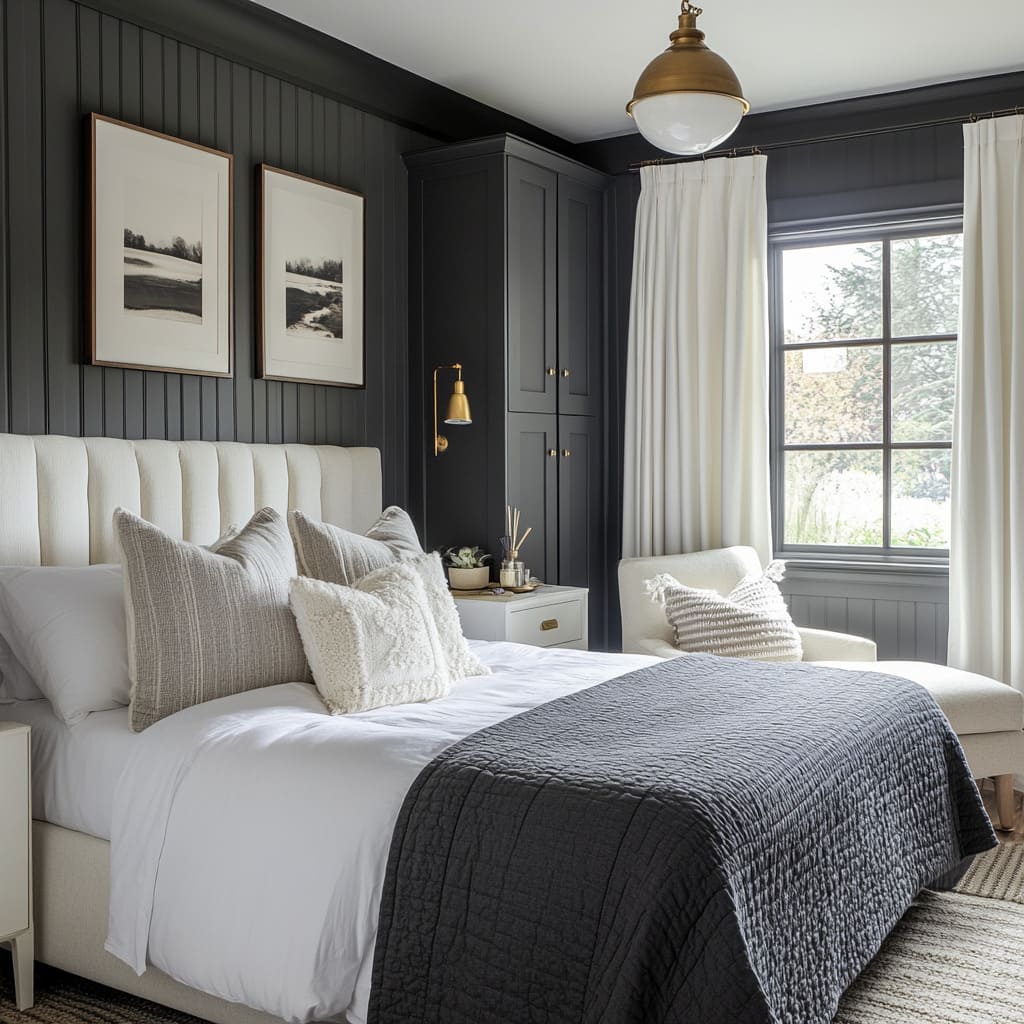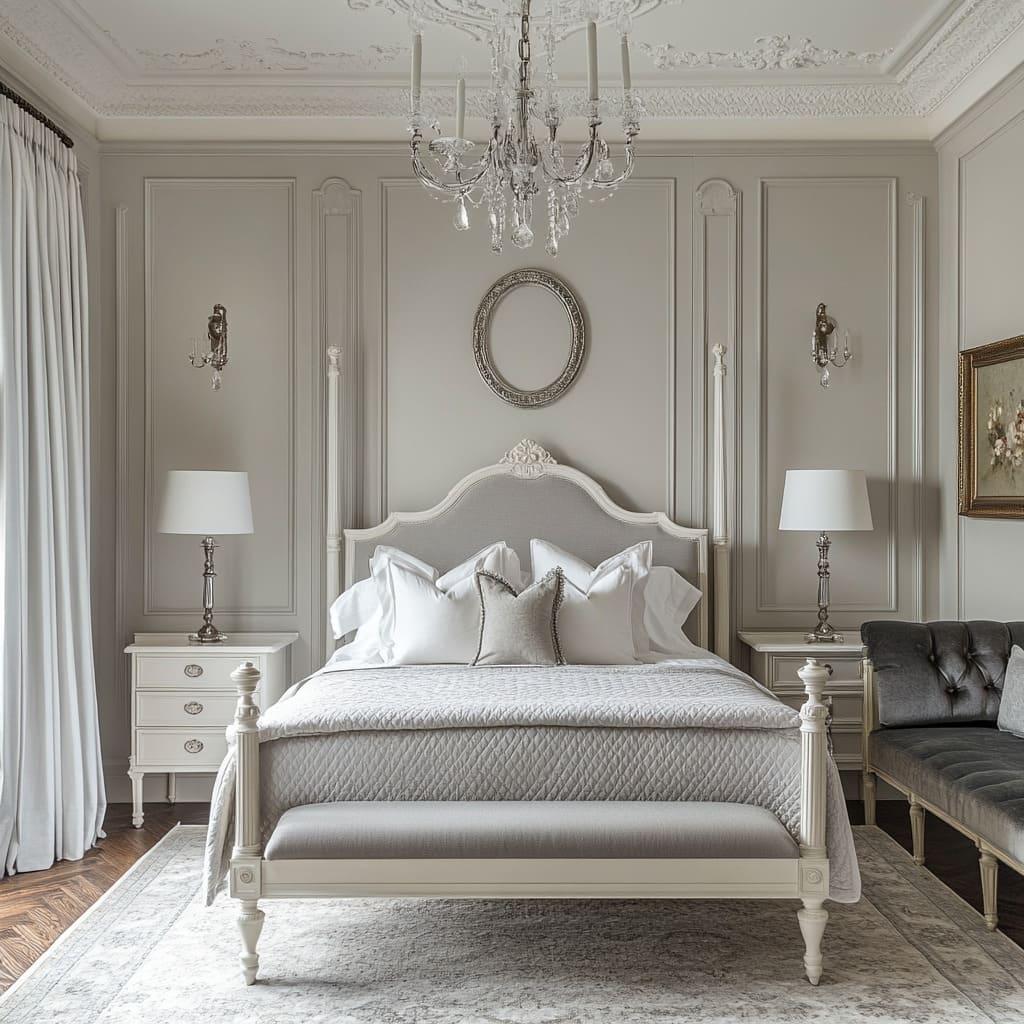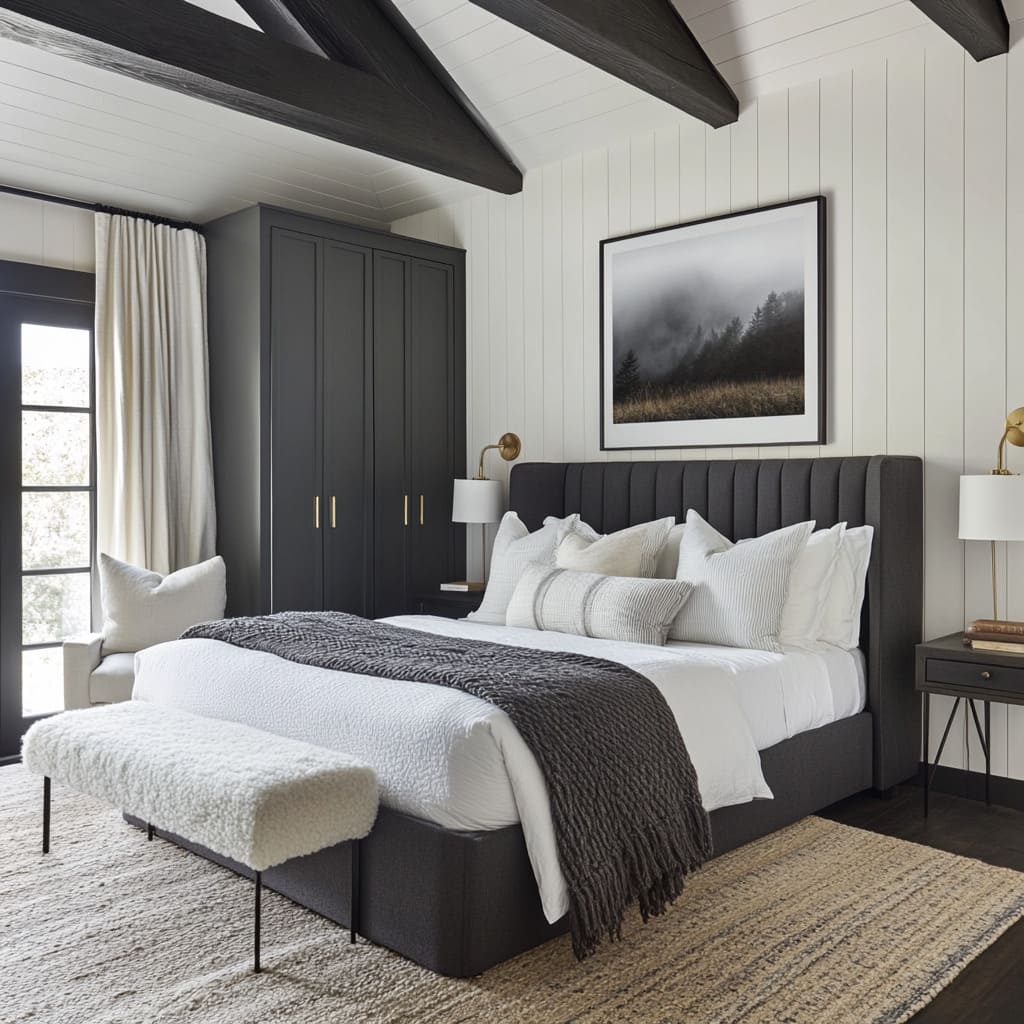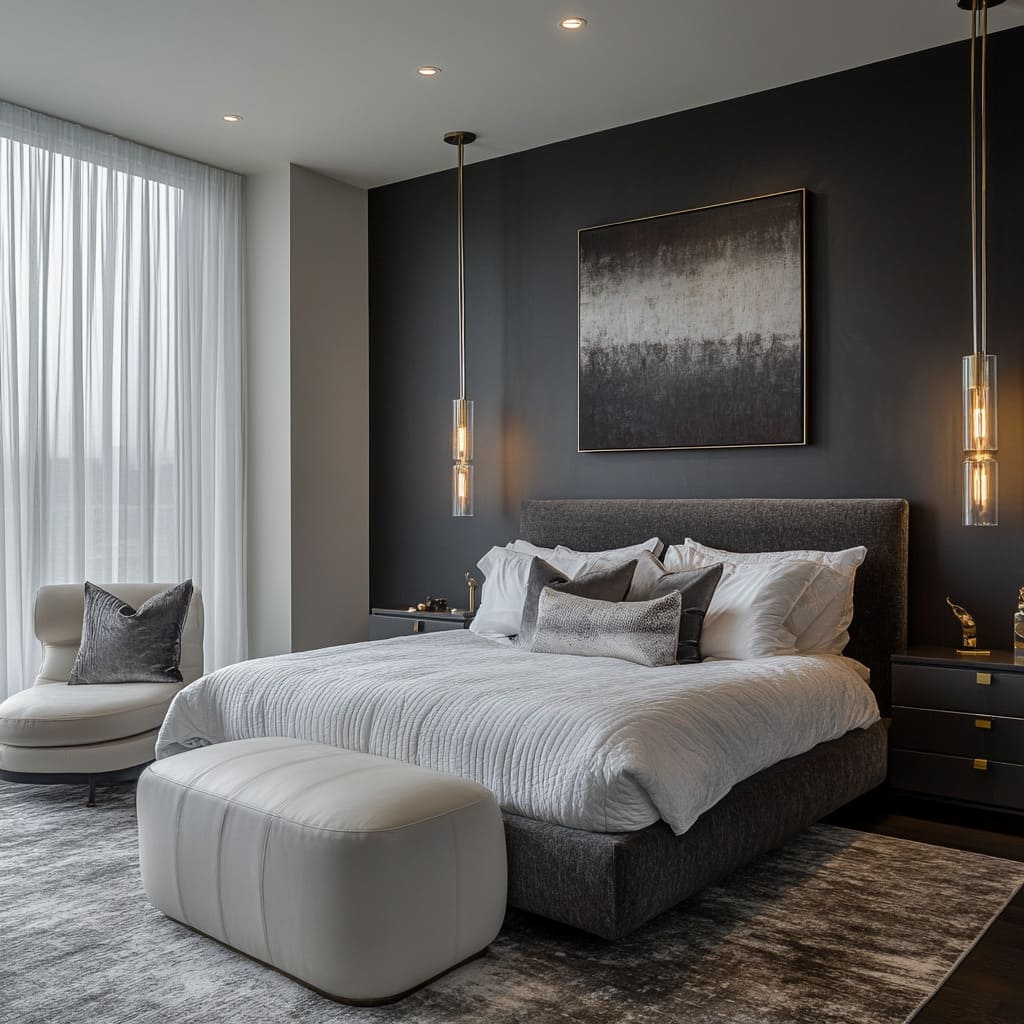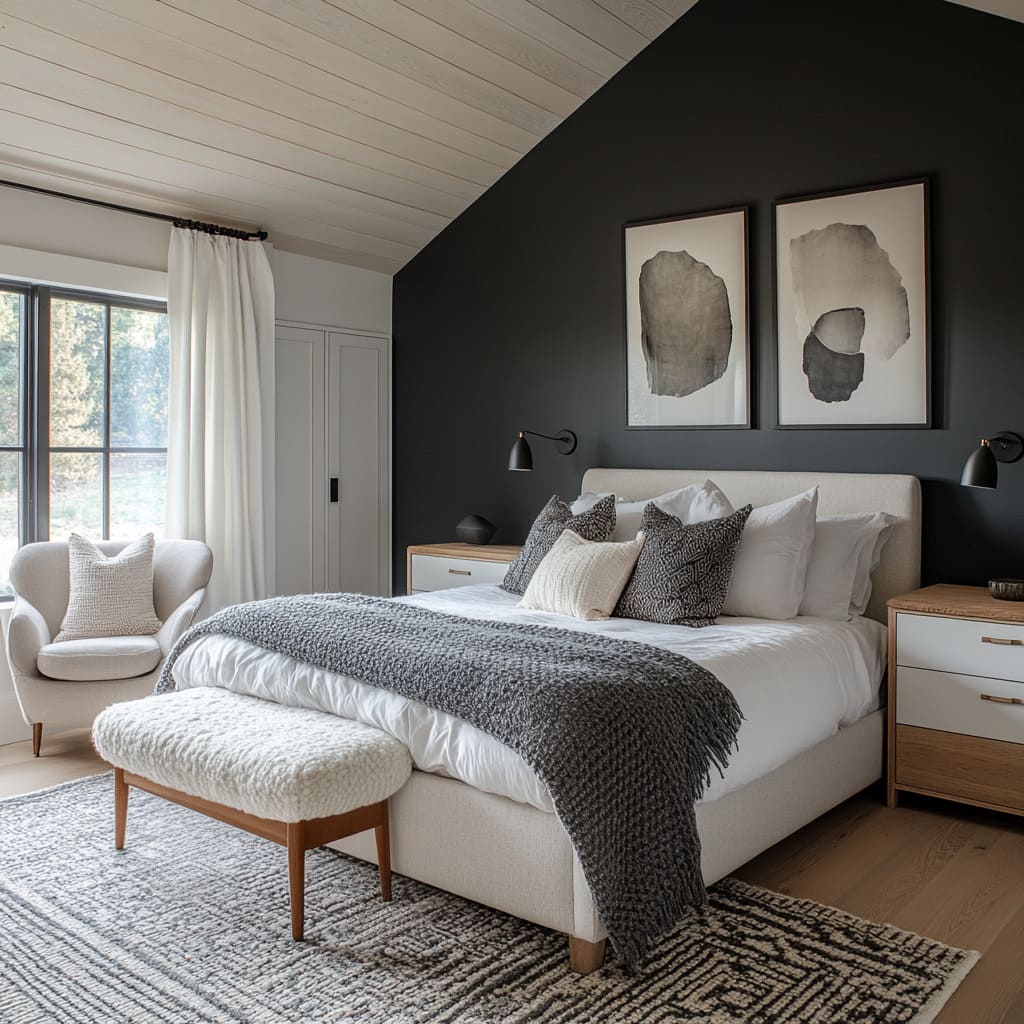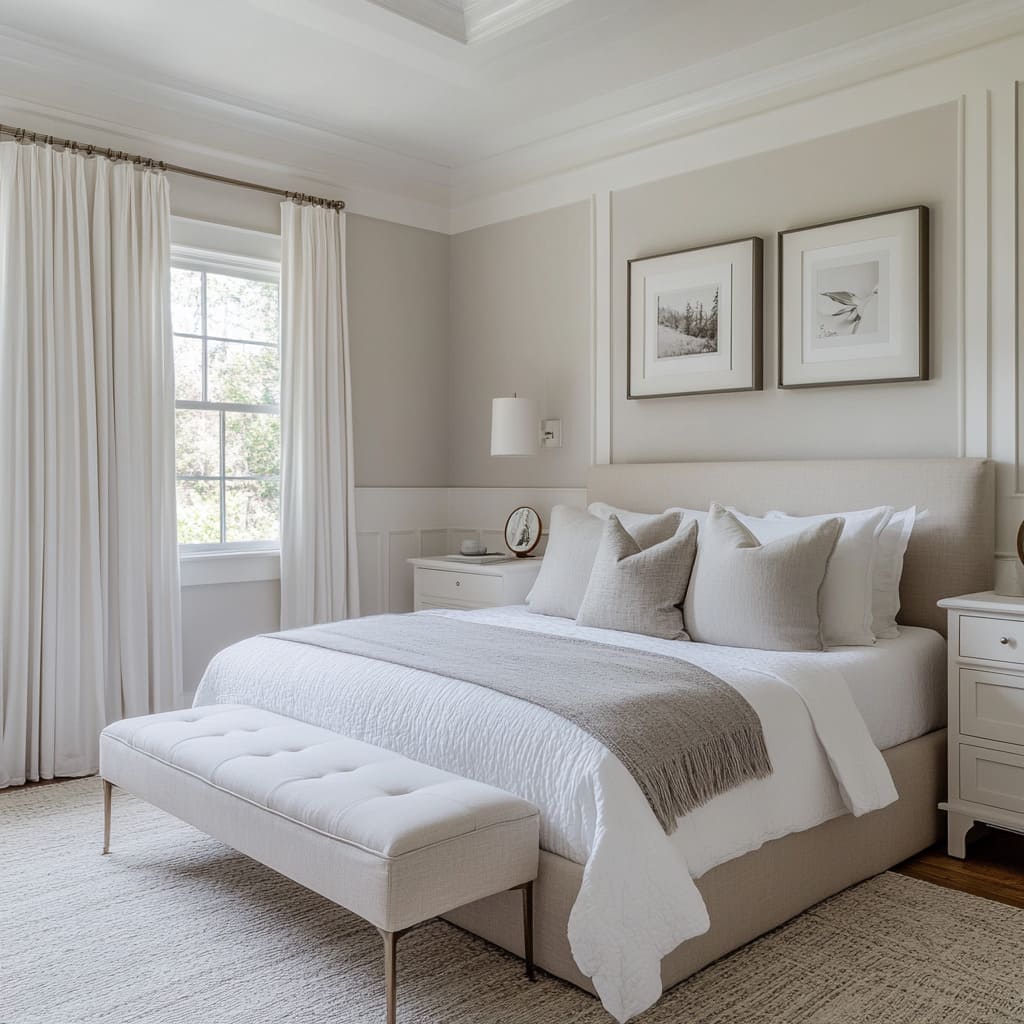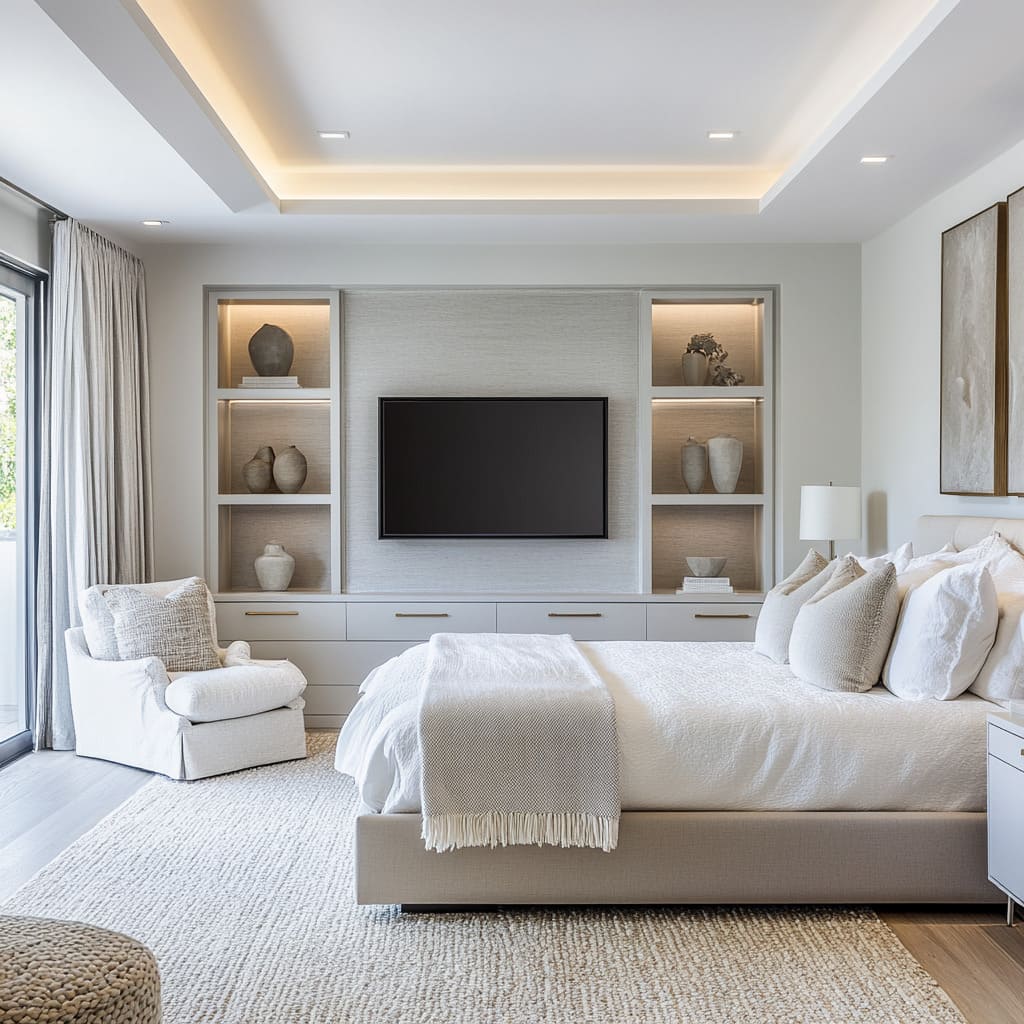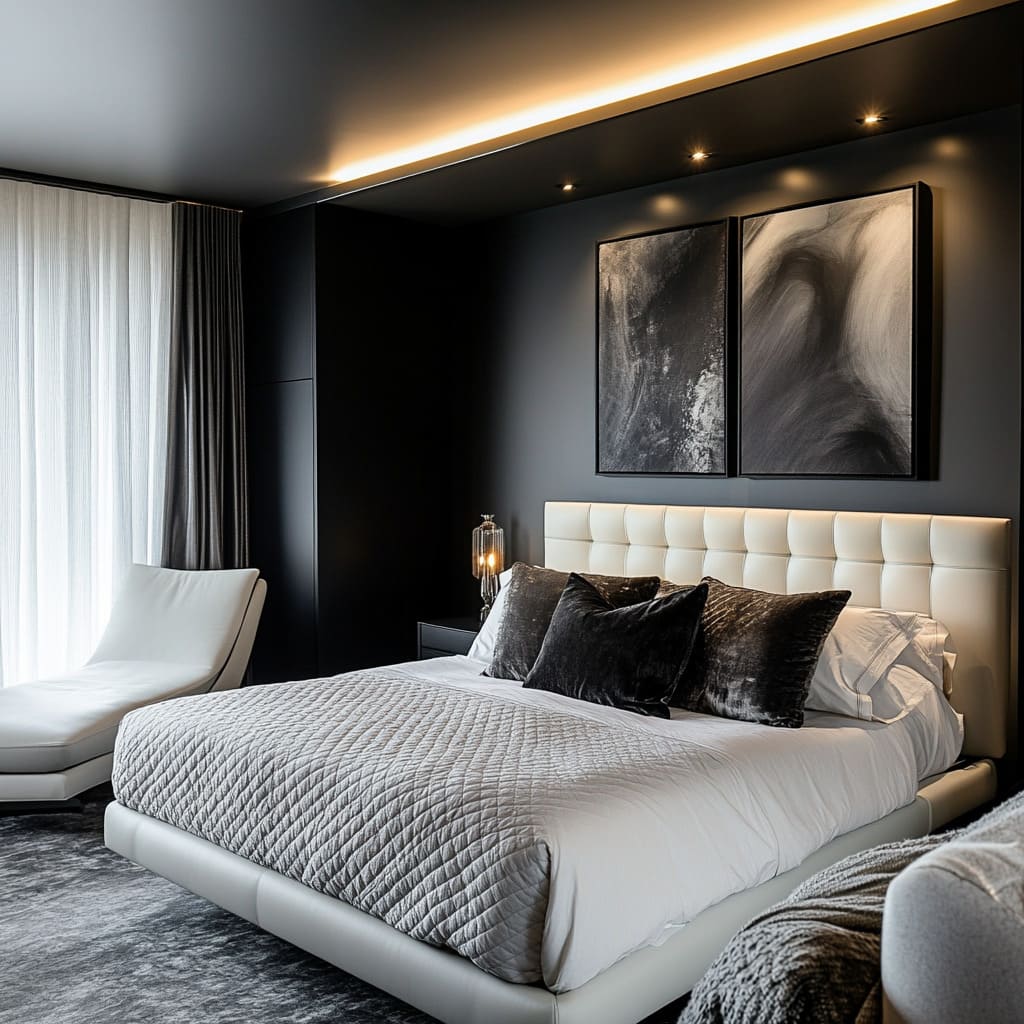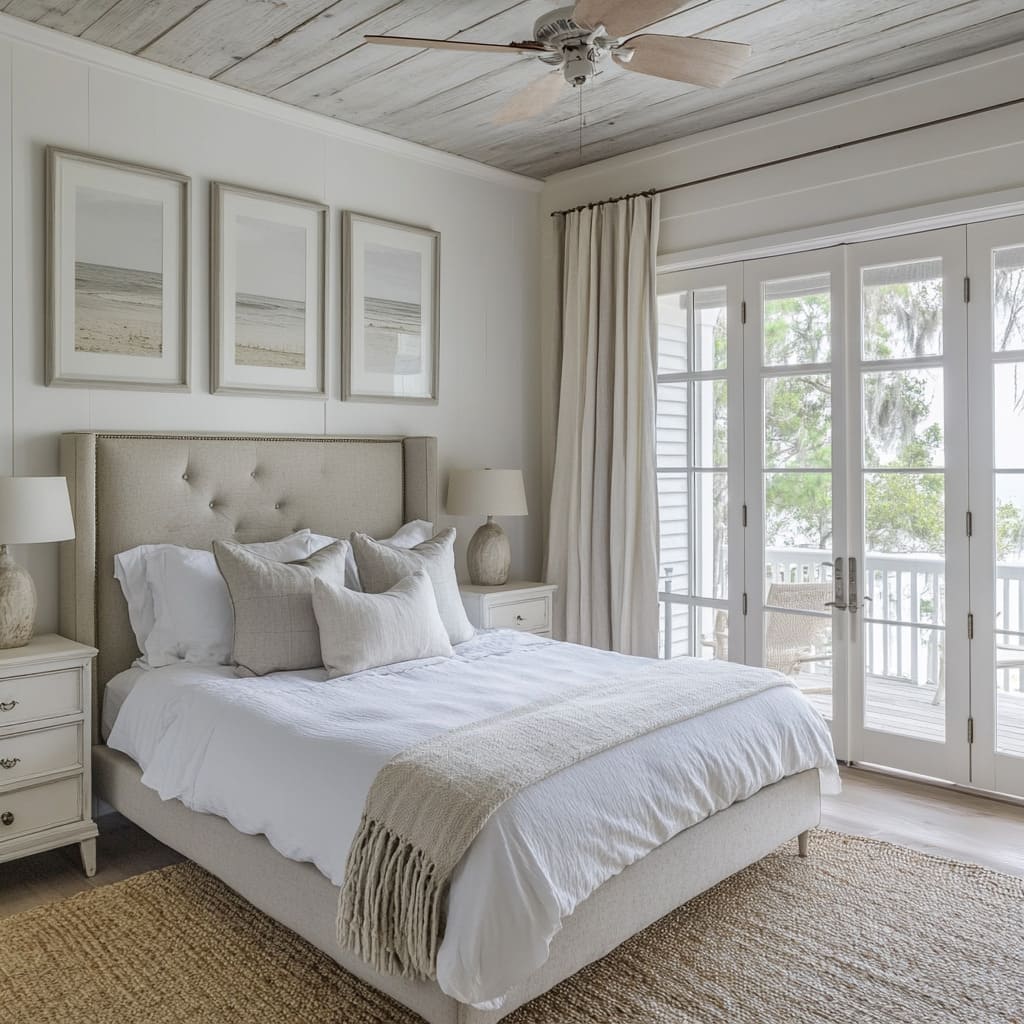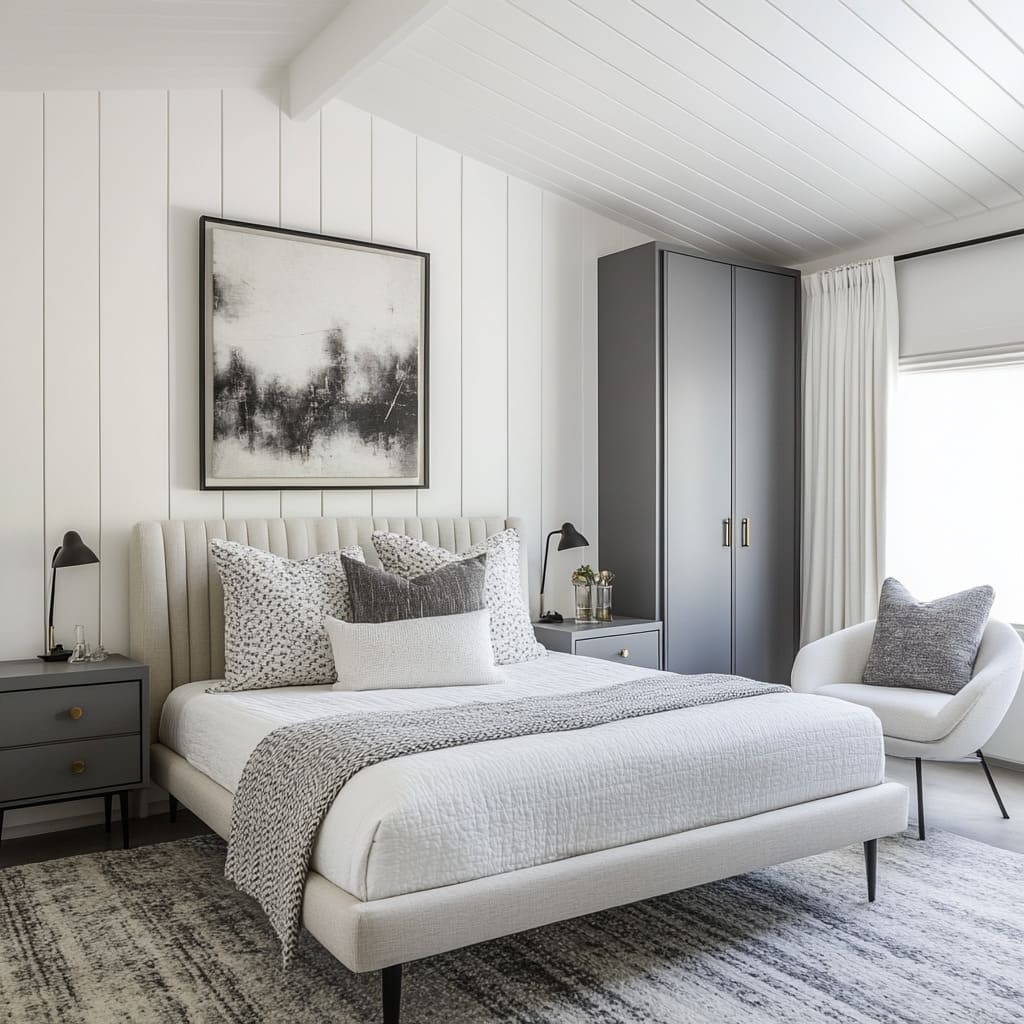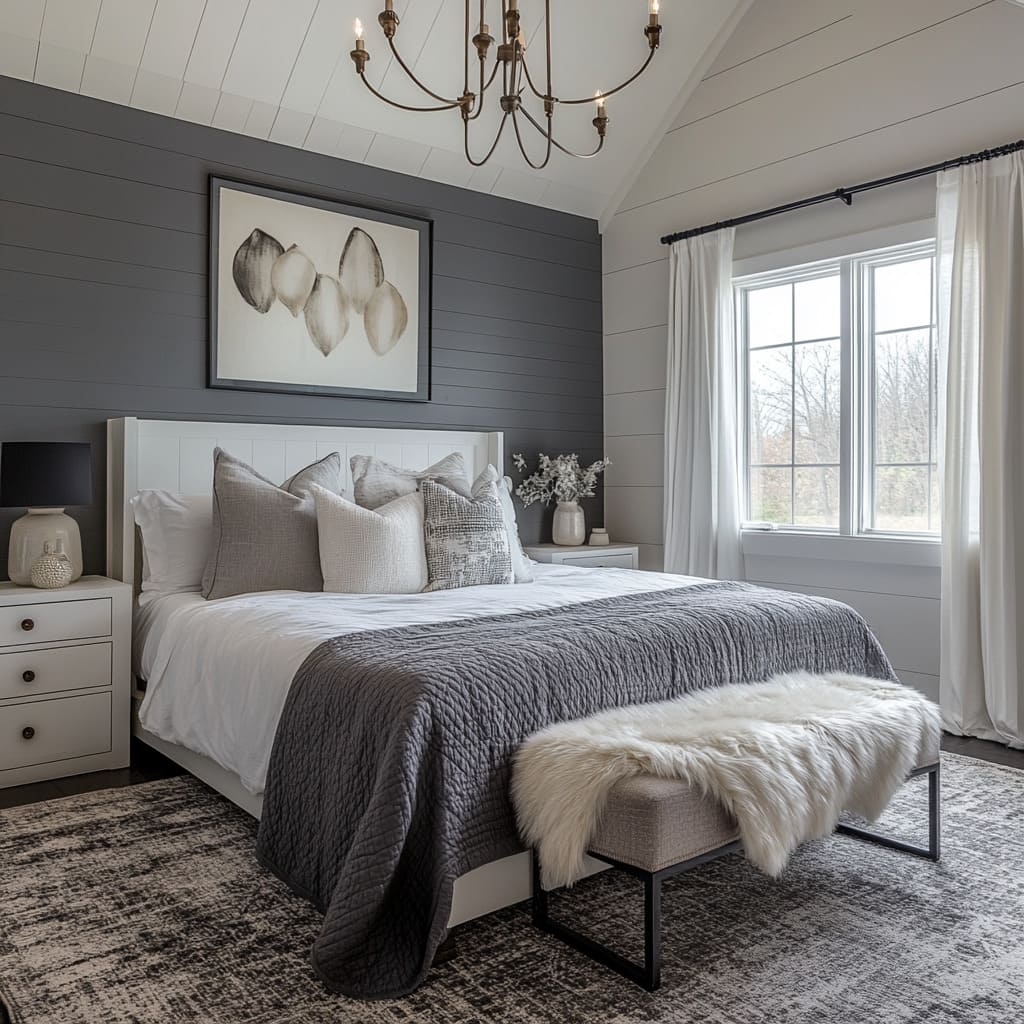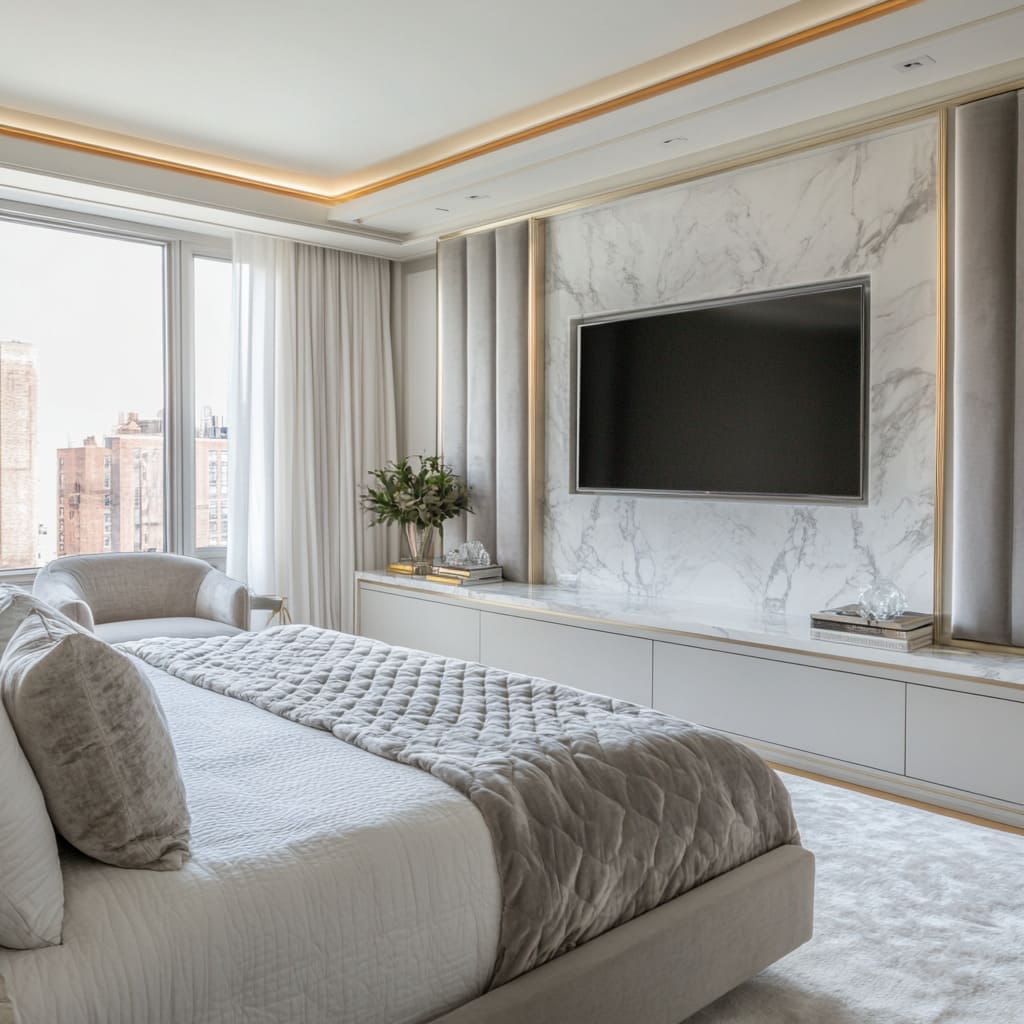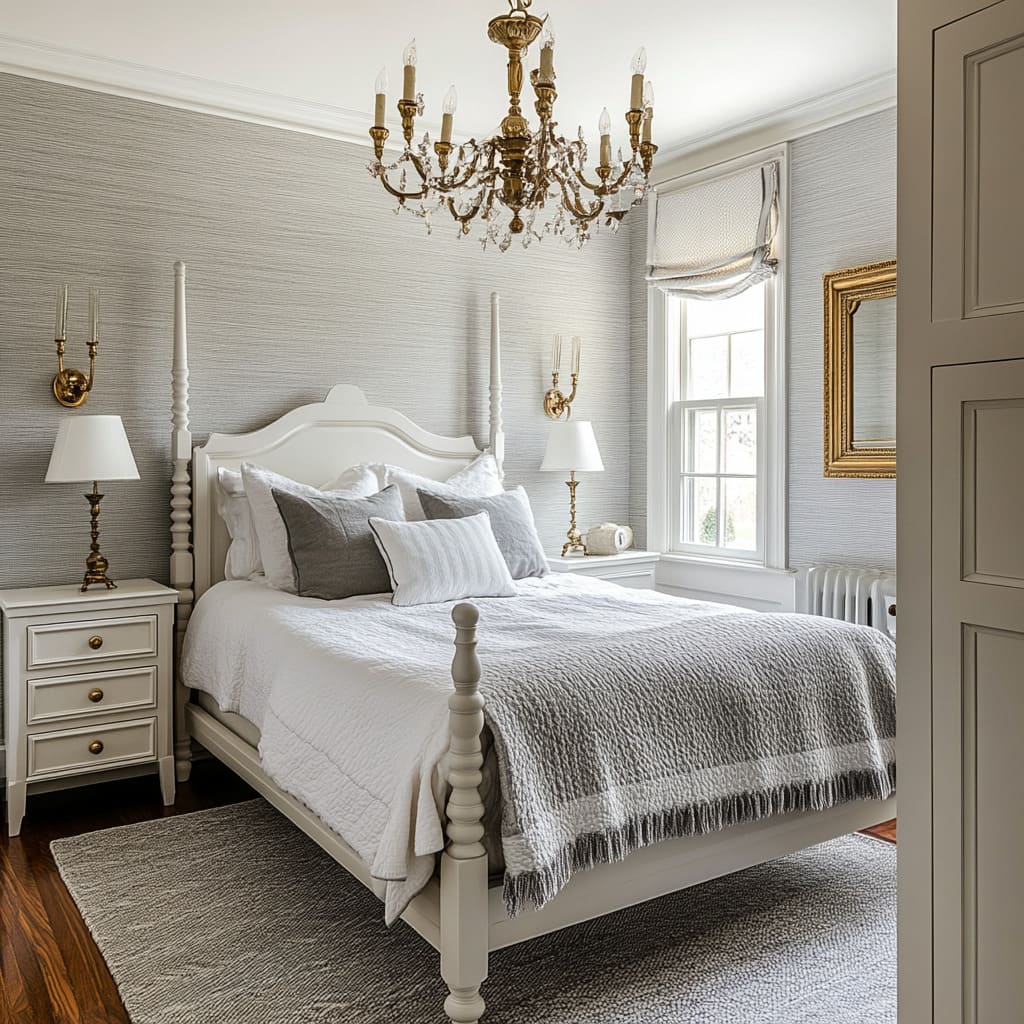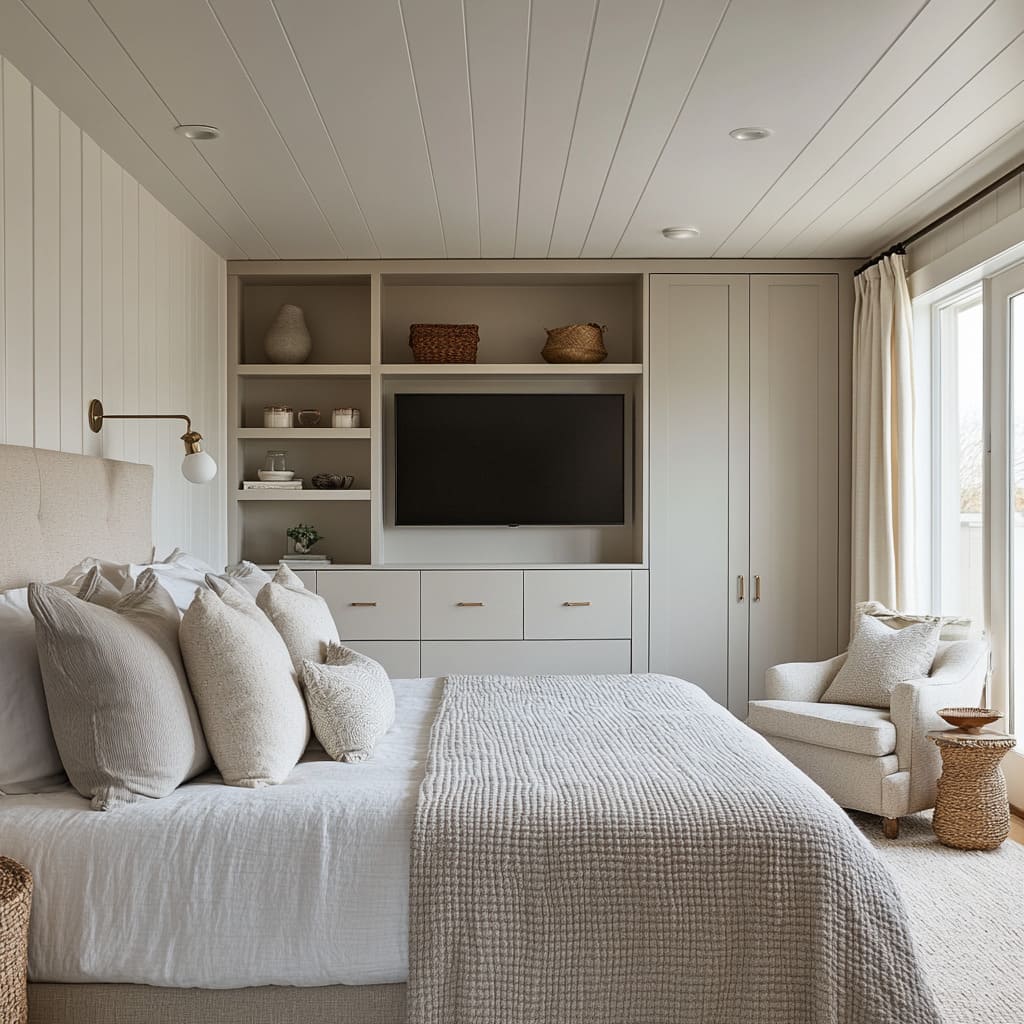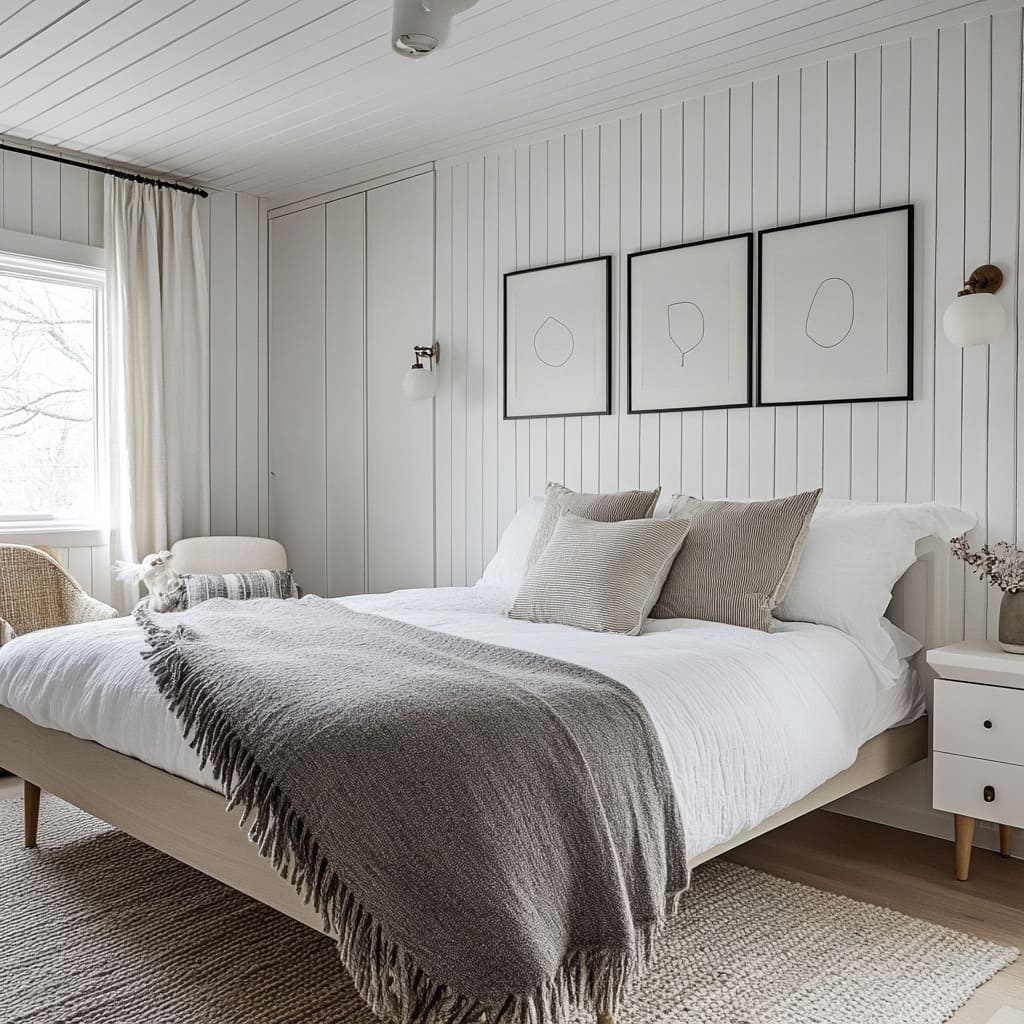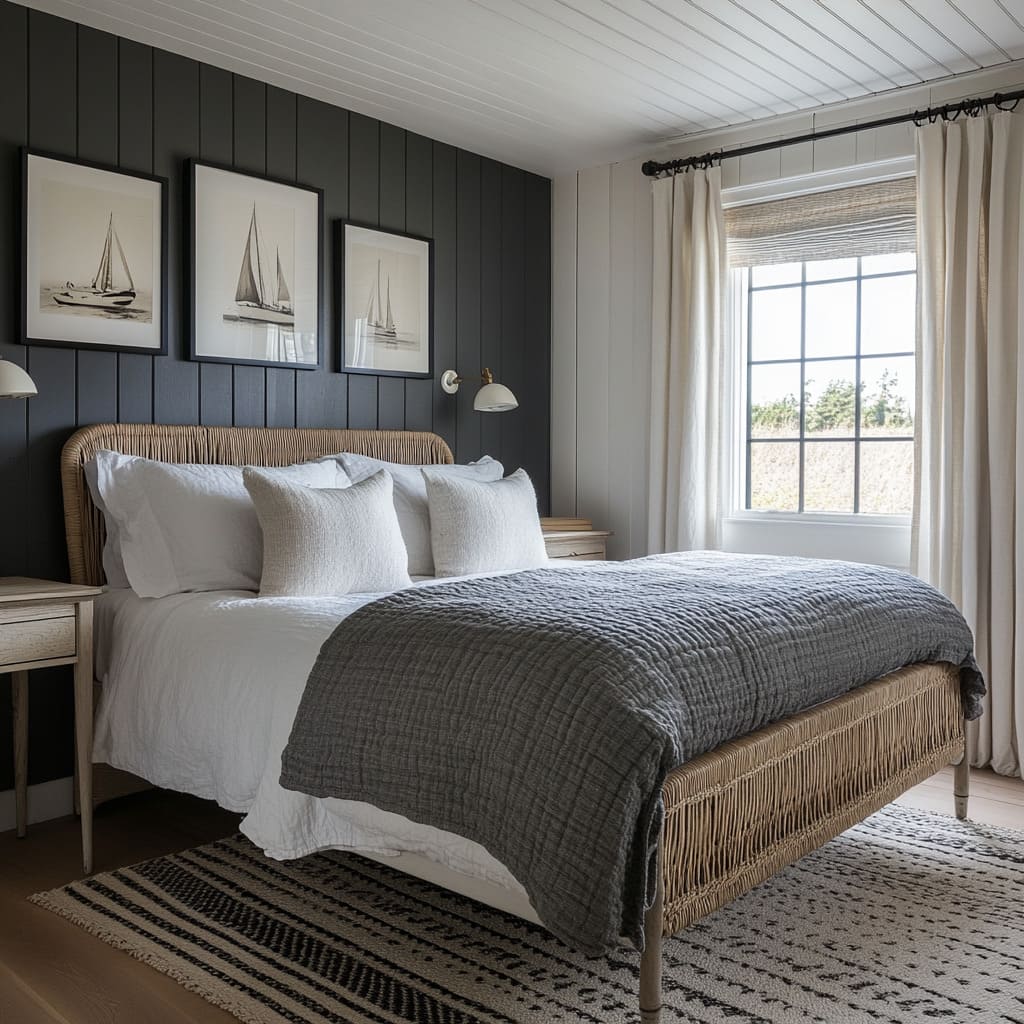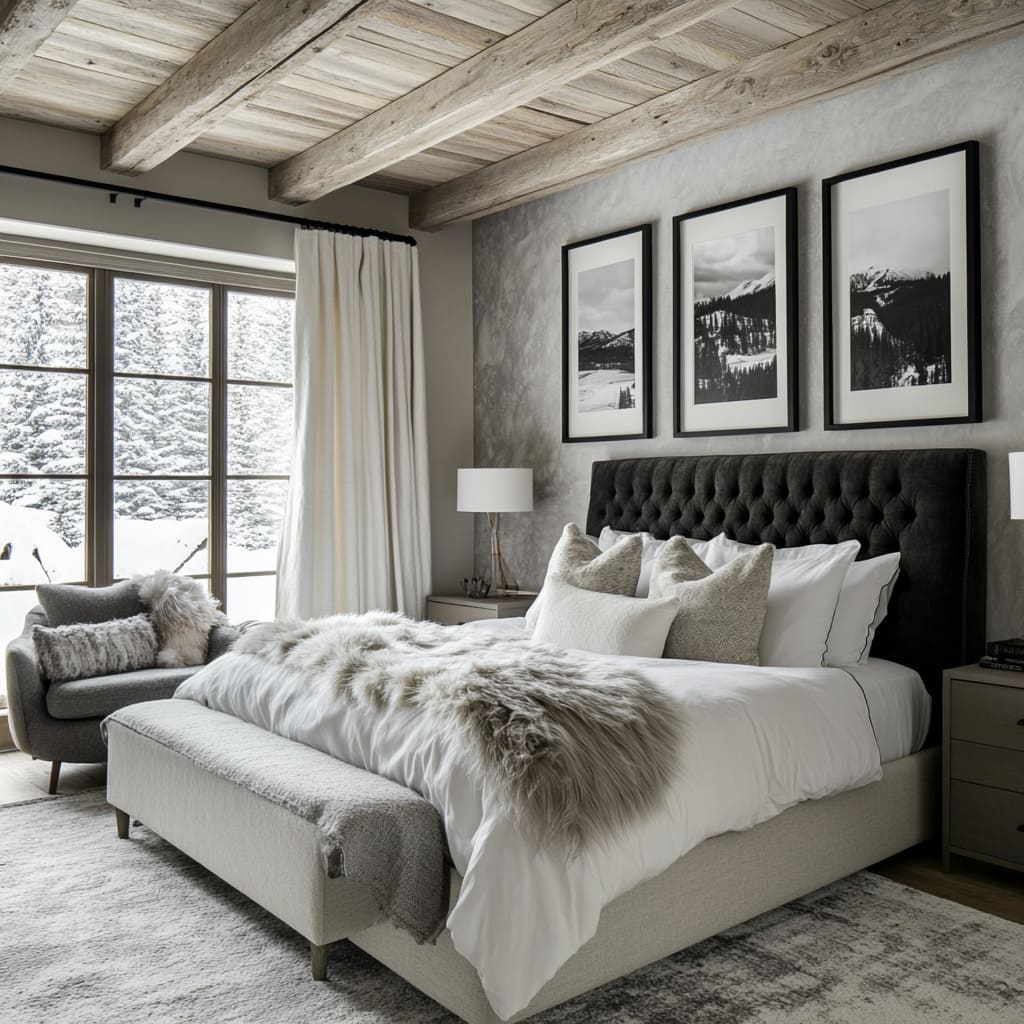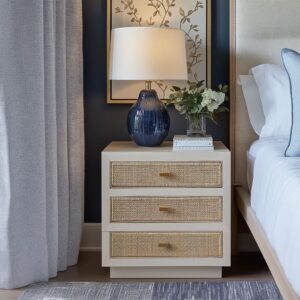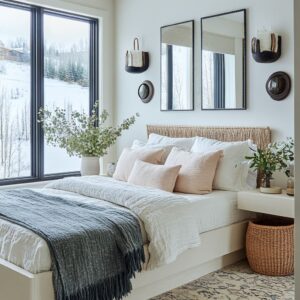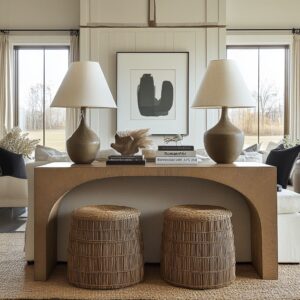Few color combinations feel as timeless and adaptable as grey and white. Whether you prefer a modern, minimal space or a cozy, layered retreat, this palette offers endless ways to shape a bedroom that feels both stylish and inviting.
The key to making it work isn’t just in picking the right shades but in balancing textures, contrast, and subtle details that bring warmth and depth.
Grey and white bedroom ideas often rely on layering different tones to avoid a flat or overly monochrome look. Soft greys paired with crisp whites create a fresh and airy feel, while deep charcoal tones add drama when used as an accent.
To keep the space from feeling too cool, designers frequently introduce natural materials like wood, woven fabrics, and stone-textured decor. Thoughtful lighting, layered textiles, and carefully chosen furniture complete the look, ensuring the space feels cohesive and well-designed.
This guide explores how to bring these elements together, from choosing the right paint undertones to selecting the perfect lighting and decorative touches. Whether you’re starting fresh or refining an existing space, these strategies will help you achieve a bedroom that feels balanced, comfortable, and effortlessly stylish.
Understanding Grey Undertones and White Variations
Why Undertones Matter
The depth and feel of a grey and white bedroom design depend heavily on the subtle undertones within each shade. Grey isn’t a single flat color—it shifts dramatically depending on lighting and surrounding elements.
Some shades lean toward warm taupe or greige, making a space feel inviting, while others carry a cool blue or sage hint, adding a crisp, modern touch. One of the biggest mistakes people make is choosing grey in isolation, without considering how it interacts with different lighting conditions.
A shade that looks perfect under store lighting may feel completely different in a room with large windows or warm-toned bulbs. If your space relies on soft yellow lighting, a grey with a slight coolness can create balance without feeling cold.
On the other hand, if your bedroom gets a lot of natural daylight, opting for a warm grey with beige or taupe undertones can prevent the space from feeling stark. When selecting fabrics or paint, it’s a good idea to test samples in various lighting throughout the day.
Morning light, afternoon sun, and evening lamplight will all reveal different aspects of the color, ensuring that it complements the room in every condition.
White Is Not One-Size-Fits-All
White may seem straightforward, but it plays just as significant a role as grey in shaping the atmosphere of a bedroom. A space that uses pure, bright white everywhere—walls, ceilings, bedding—can sometimes feel too stark or even sterile.
That’s why designers carefully mix shades of white to introduce warmth and depth without overwhelming the space. A classic trick is to use crisp white on ceilings and trim, which naturally reflects light and gives a clean architectural definition.
Then, a softer off-white can be applied to walls, preventing the room from feeling too sharp. This approach creates a subtle contrast that gives depth to the design without introducing bold colors.
For textiles, slightly off-white fabrics—whether linen curtains, quilted coverlets, or throw pillows—help bridge the gap between white and grey, making the space feel more layered and inviting. These small variations in tone make a noticeable difference, ensuring that a grey and white bedroom looks sophisticated rather than flat.
The key takeaway? Grey and white are not just a color combination but a balancing act.
The right mix of undertones and white variations transforms a space into something inviting, structured, and visually interesting.
Strategic Use of Contrast
Deep Charcoal for Drama
One of the most striking ways to add depth to a modern grey and white bedroom is through contrast. A dark charcoal wall immediately becomes the room’s focal point, giving a sense of structure and refinement.
Instead of blending into the background, architectural elements such as crown molding, wall paneling, or built-in shelving gain prominence, creating a well-defined look.
To make the contrast even stronger, designers often integrate built-in wardrobes in the same deep grey as the feature wall. This approach keeps storage seamless, preventing bulky furniture from interrupting the flow of the design.
When combined with crisp white bedding, bright ceilings, and strategically placed lighting, a deep grey accent wall enhances the room’s depth without making it feel heavy.
The key is balance—allowing dark tones to highlight architectural details while ensuring that enough white elements remain to reflect light. If the room has large windows, natural daylight will prevent the deep grey from feeling too dominant.
In smaller spaces, pairing a dark feature wall with white trim, furniture, and light-colored flooring keeps the overall atmosphere inviting while still making a strong statement.
Light Grey for a Calming Flow
For a softer take on contrast, many designers choose light grey walls as a backdrop for white ceilings, doors, and furniture. This method maintains a sense of openness while adding a refined layer of depth.
Unlike stark white walls, which can sometimes feel flat, a light grey tone introduces a natural warmth and dimension to the space.
This style is often seen in Scandinavian and coastal-inspired interiors, where the focus is on maximizing natural light. In these settings, whitewashed wooden beams, linen drapes, and soft-textured bedding work together to enhance the airiness of the design.
The trick is to let the contrast be subtle, allowing variations in grey and white to create a sophisticated transition between different elements in the room.
Even with a lighter grey palette, contrast can still play a role. A white upholstered bed against a soft grey wall, or a grey wool rug on a white oak floor, brings just enough variation to keep the space visually interesting without overwhelming it.
The result is a bedroom that feels both refreshing and well-balanced—a space where contrast isn’t about bold statements, but about refining the way light and shadow interact.
Layered Textiles and Bedding Tactics
Multiple Pillow Heights and Textures
One of the easiest ways to make a bed look thoughtfully designed is by layering pillows of different heights, shapes, and fabrics. Instead of sticking to a uniform material, mixing linen, cotton, velvet, and knit textures adds variety without needing bold colors.
A combination of soft neutrals—white, off-white, grey, and subtle beige—helps create a plush, inviting arrangement.
The key to achieving this layered effect is in the stacking. Large Euro pillows serve as the foundation, followed by standard-sized sleeping pillows, decorative cushions, and a lumbar pillow for a structured finish.
While crisp white pillows keep the look fresh, adding muted grey or soft woven fabric prevents the arrangement from feeling overly plain. Texture also plays a major role.
A matte linen pillow next to smooth cotton creates a quiet contrast, while a chunky knit lumbar pillow adds warmth.
Throws and Coverlets
A well-made bed isn’t complete without an extra layer of texture at the foot. The most successful grey-and-white bedroom ideas incorporate at least one element that breaks up the smooth expanse of sheets—whether it’s a quilted coverlet, ribbed blanket, or loosely draped knit throw.
One of the most effective techniques is layering different types of blankets. A quilted coverlet brings subtle structure, while a thick knit throw draped over the corner adds softness.
For an understated look, keeping the color palette neutral is best. A soft grey coverlet on white sheets or a deep charcoal throw on a pale grey duvet creates just enough contrast.
Architectural and Furniture Details
Paneling and Molding
The walls in a bedroom do more than hold up decor—they shape the entire atmosphere of the space. Paneling and molding bring structure and depth, whether it’s vertical shiplap for a farmhouse feel or decorative molding for classic elegance.
A clever trick in grey-and-white bedrooms is using contrast to highlight paneling. Soft grey walls with crisp white trim enhance architectural lines, while monochromatic grey wainscoting softens details, allowing texture to take center stage.
For a contemporary look, thin vertical panels add height, making ceilings appear taller.
Built-Ins and Concealed Storage
Storage is often a challenge, but built-ins maintain a clean, streamlined look. Custom wardrobes, shelving units, and recessed benches blend effortlessly into the walls when painted in the same grey tone, eliminating visual bulk.
To keep these built-ins from looking too flat, open shelving introduces personality through neutral-toned ceramics, books, and small sculptures.
Nightstands and Benches
Every well-designed bedroom benefits from symmetry, and matching nightstands bring just that. White or light grey nightstands with metallic accents—whether brass, black iron, or brushed nickel—help tie in lighting and decor.
If space allows, a bench at the foot of the bed serves both a functional and decorative purpose. Upholstered benches in soft grey or beige add comfort, while those with wooden or metal legs introduce structure.
The key is balance—ensuring that furniture enhances the room’s design without overpowering it.
Lighting: A Functional and Decorative Element
Layered Light Sources
A well-designed grey and white room theme isn’t just about color—it’s about how light interacts with those shades to create depth and mood. Lighting plays a key role in making the space feel balanced, and a single overhead fixture isn’t enough to achieve that effect.
That’s why designers rely on a layered approach, incorporating multiple light sources to highlight different elements of the room.
Overhead lighting, whether a chandelier, a pendant fixture, or a modern ceiling fan with integrated LEDs, provides general illumination. But what really defines the space is the addition of softer, more focused lighting.
Wall sconces beside the bed add a warm glow, drawing attention to textures like paneled walls or upholstered headboards. Meanwhile, bedside table lamps provide functional lighting for reading while also acting as a design feature.
Floor lamps help fill gaps in illumination, ensuring that every part of the room has the right level of brightness. With the ability to adjust different light sources throughout the day, the space can shift from bright and open in the morning to soft and intimate at night.
Metallic Finishes for Warmth
While a grey-and-white palette can sometimes lean cool, lighting fixtures offer an opportunity to add warmth. Gold and brass accents on lamps, sconces, and chandeliers introduce subtle contrast, preventing the space from feeling too monochromatic.
For those who prefer a more modern approach, black iron or matte black finishes provide an alternative way to create contrast. A black metal chandelier against a white ceiling draws the eye upward, while wall sconces with black arms can frame the bed in a striking way.
By blending layered lighting with thoughtful material choices, a grey-and-white bedroom transforms into a space that not only looks sophisticated but also feels comfortable at any time of day.
Textural Mixes and Organic Elements
Rattan, Wood, and Natural Fibers
A grey-and-white bedroom design gains warmth and depth when natural materials are introduced. The mix of soft textiles with elements like rattan, raw wood, and woven fibers prevents the space from feeling too sleek or rigid.
These materials work as a bridge, balancing the cool tones of grey with the warmth of organic textures.
One way to incorporate this is through a rattan headboard, which softens the structured look of a bed while adding a subtle pattern. Woven benches at the foot of the bed serve a similar purpose, giving the space a laid-back, inviting quality.
If the room features grey walls, lighter woods like whitewashed oak or light maple help maintain an airy atmosphere. In contrast, deeper wood tones like walnut or rustic pine introduce a grounding effect.
Ceiling beams in a natural or weathered finish add texture overhead, whether left raw for a rustic effect or lightly stained to match the decor. Even small touches, like a woven light fixture or a wooden side table, make a noticeable difference in adding warmth to the room.
Layering Rugs
Flooring plays a crucial role in pulling together a bedroom’s look, and even in spaces with beautiful hardwood or concrete floors, a rug is essential. Beyond just being a soft surface underfoot, a well-chosen rug brings in extra texture and pattern, preventing the space from feeling one-dimensional.
A common approach in grey-and-white rooms is to opt for a neutral rug with subtle detailing. Distressed Persian-inspired designs, geometric motifs, or natural fiber options blend effortlessly into the color scheme while introducing depth.
Placing a large area rug under the bed, with enough space extending beyond the sides, helps define the sleeping area.
For a more layered look, adding a smaller, textured rug on top of a larger neutral base enhances visual interest. A high-pile or woven rug over a flat-weave option creates contrast, making the space feel more inviting.
Blending these natural elements into a grey-and-white bedroom ensures the space doesn’t feel overly polished or cold. The right mix of textures creates a setting that feels thoughtfully designed, comfortable, and visually engaging.
Wall Art and Decorative Elements
Focus on Monochrome Artwork
A well-balanced grey-and-white bedroom doesn’t need bold artwork to make an impact. Instead, designers often turn to monochrome pieces that blend into the color scheme while adding visual depth.
Black-and-white photographs, abstract prints, or architectural sketches are all effective choices, allowing the artwork to enhance the space without overpowering it.
Thin black or gold frames keep things structured while introducing a subtle contrast. A gallery-style arrangement of framed sketches above the bed can bring a refined yet understated focal point.
For a modern touch, oversized abstract prints with soft grey gradients or geometric compositions reinforce the room’s layered aesthetic. Monochrome landscapes work particularly well in a grey-and-white palette, providing a sense of openness without introducing distracting colors.
Whether it’s a misty coastal scene, a minimalist mountain range, or a line drawing of an iconic cityscape, these pieces contribute to the atmosphere without overwhelming the decor.
Keeping Accessories Subtle
Accessories in a grey-and-white bedroom are about form and texture rather than vibrant colors. Rather than using bold decorative items, the focus is on neutral ceramics, sculptural elements, and carefully curated objects that complement the design.
Smooth white vases, matte-finish sculptures, or organically shaped bowls in soft grey introduce subtle variations in texture. Stacking a few neutral-colored books on a nightstand or shelf creates a layered look, while a single stone or concrete decorative piece adds weight and dimension.
For those looking to add a metallic element, brushed gold or black iron details in picture frames, candleholders, or light fixtures bring warmth without disrupting the room’s balance. Even small touches, like a linen-covered storage box or a woven basket tucked under a nightstand, add quiet character while keeping clutter hidden.
By keeping accessories minimal and intentional, a grey-and-white bedroom remains visually interesting without feeling overdecorated. Every detail contributes to the sense of cohesion, creating a space that feels refined and comfortable.
Window Treatments and Ceiling Considerations
Curtain Height and Material
Window treatments are more than just functional—they shape how a bedroom feels and looks. One of the simplest ways to create a sense of height is by hanging curtains well above the window frame.
This small adjustment draws the eye upward, making the ceiling appear taller and the room feel more spacious.
For a balanced look, light and airy fabrics work best. Sheer white or off-white curtains allow natural light to filter through, softening the overall atmosphere.
This is especially important in bedrooms with darker grey walls, where bright, flowing drapery prevents the space from feeling too heavy. If blackout curtains are needed, layering them with sheer panels maintains a soft, layered effect.
Another detail that makes a difference is the curtain rod. A sleek black or brushed brass rod adds a polished touch, while extra-wide curtains ensure full coverage when drawn.
The goal is to frame the window in a way that enhances brightness and complements the room’s color palette.
Ceiling Beams or Paneling
The ceiling is often overlooked in bedroom design, but adding texture overhead can completely change the feel of the space. Exposed beams, tray ceilings, or paneling introduce character, preventing the room from feeling too plain.
In a grey-and-white bedroom, natural wood beams add warmth, especially when the walls lean toward cool tones. Whitewashed or light oak beams work beautifully in coastal-inspired or Scandinavian-style spaces, maintaining an airy and relaxed feel.
In more traditional settings, painted white beams provide structure while keeping the ceiling from feeling too dominant.
For a modern approach, paneling on the ceiling adds depth without requiring exposed beams. Whether done in simple vertical planks or a coffered design, this technique creates a refined architectural element.
If the room already features decorative molding, continuing the detail onto the ceiling ties everything together, making the design feel intentional and complete. By carefully choosing window treatments and ceiling details, a bedroom gains a sense of balance and proportion, ensuring that both vertical and horizontal elements work together to create a cohesive and visually appealing space.
Balancing Comfort and Style
Color Harmony Across Elements
A well-designed grey-and-white bedroom isn’t just about picking the right shades—it’s about making sure every element works together. The best spaces have a natural flow, where furniture, textiles, and accessories complement rather than compete.
The key to achieving this is subtle repetition. If the walls are deep grey, white nightstands and a matching white headboard keep the contrast crisp.
On the other hand, if the walls are light grey, introducing a mix of white and soft greys in the bedding and decor prevents the space from feeling too uniform.
One of the easiest ways to tie these elements together is through small bridging accents. A grey throw over a white duvet or a light grey rug beneath a white bed frame helps create a seamless connection between contrasting tones.
Even small details, like a bedside lamp with a white shade and a grey base, can reinforce the color balance. Layering different shades of grey enhances the depth of the room.
Instead of relying on a single grey tone, using a combination of warm and cool variations creates a more refined look.
Temperature Control in Color
Grey has a naturally cool undertone, which can sometimes make a bedroom feel stark, especially when paired with bright white. The best way to soften this effect is by introducing warm neutrals like beige, taupe, or light wood.
These elements bring warmth without disrupting the monochrome aesthetic. A wooden bench, light oak nightstand, or woven rattan accent chair subtly counterbalances the cooler greys.
Upholstered elements in warm beige or textured linen help break up the contrast between white and grey.
If the walls lean toward darker grey, layering in plush white elements—such as a thick shag rug or crisp white bedding—prevents the space from feeling too heavy. On the flip side, if the room is predominantly white with light grey accents, grounding the space with a slightly darker grey furniture piece or a textured grey area rug adds depth without overwhelming the brightness.
Balancing comfort and style in a grey-and-white bedroom is about creating contrast in a way that feels natural. By carefully selecting textures, finishes, and small accents, the space feels inviting, layered, and effortlessly stylish.
Practical Tips for Recreating the Look
Transforming a space with a grey and white bedroom theme requires attention to subtle details that go beyond just choosing the right shades. While this color palette may seem straightforward, the way tones interact with light, textures, and accents determines the final outcome.
Here’s how to achieve a balanced and polished look:
Test Paint Samples Before Committing
Grey is one of the most sensitive colors when it comes to undertones. A shade that looks perfect on a sample card can shift dramatically once it’s on the walls, especially under different lighting conditions.
Large test swatches are essential—apply them in different areas of the room and observe how they change throughout the day.
Mix Different Shades of White
Not all whites are the same, and layering different tones helps avoid a sterile appearance. A bright, crisp white works well on ceilings and trim, creating sharp contrast against grey walls.
However, for curtains, bedding, and upholstery, an off-white or warm white introduces a softer, more inviting feel.
Use Texture to Add Dimension
Since grey and white rely on subtle contrast, texture plays a key role in making the space feel layered and inviting. A mix of materials—knit blankets, linen pillows, quilted bedspreads, or woven rugs—keeps the design from feeling flat.
Incorporate Metallic or Black Accents
To give the room definition, small details in metal or black finishes can create contrast without introducing a completely new color. Black iron curtain rods, matte black door handles, or dark-framed mirrors add structure.
For a slightly warmer look, gold or brass elements—like light fixtures, picture frames, or drawer pulls—introduce a refined touch that balances cooler grey shades. By carefully layering tones, textures, and accents, a grey-and-white bedroom can feel anything but plain.
The key is to let each element work together, creating a space that is both comfortable and visually cohesive.
In Summary
Creating a grey-and-white bedroom isn’t just about choosing two colors—it’s about how they interact through layering, contrast, and texture. The most successful designs incorporate multiple shades of grey, from soft misty tones to deep charcoal, paired with distinct white variations that prevent the space from feeling flat.
Instead of relying on color alone, designers use a mix of plush rugs, woven benches, and textured bedding to add warmth and character. Small but intentional details, like a metallic lamp or dark hardware, help define the space without disrupting the balance.
To achieve this look, consider the unique qualities of your space. The amount of natural light, architectural elements, and personal style all play a role in how different shades of grey and white will appear.
A room with high ceilings might benefit from exposed beams or paneling for depth, while a smaller space may feel more open with light grey walls and crisp white trim.
The key to making a grey-and-white bedroom feel inviting rather than cold is in the layering—of color, fabric, and subtle contrasts. By thoughtfully blending textures and adjusting undertones to suit your lighting conditions, you can create a space that feels balanced, calming, and intentionally designed.


